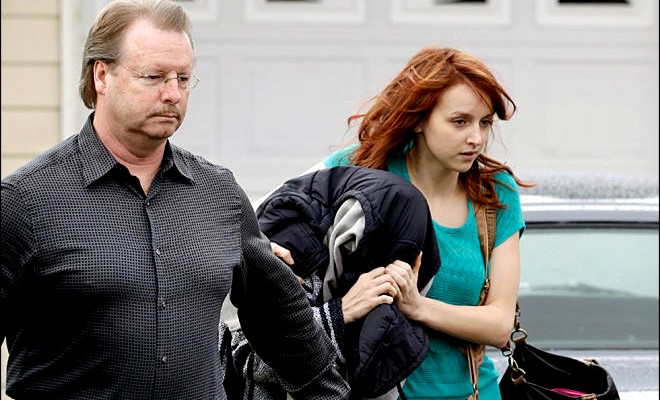
Category: Defendants in court
Sunday, May 11, 2014
Knox Interrogation Hoax #1: Masterlist Of Posts Re Pre-Trial Events And Hoax Overview
Posted by Our Main Posters

Perugia Central Police Station at night (left-center)
1. Masterlist Of Posts In The Series
The Interrogation Hoax series will consist of a total of 24 posts.
These posts quote from a large number of transcripts only recently acquired and translated. There are no serious conflicts, no gray areas. One can assume with total certainty that this is the real thing (see Part 3 below), and that any other versions (see Part 4 below) are fabricated.
Numbering of posts 1-24 is not chronological, it represents the original order of postings.
1. What Happened At AK & RS Q&A Prior To 6 Nov
Click for Post: #19: ALL Knox Q&A Sessions 2-6 November 2007 WERE Recorded #1
Click for Post: #20: ALL Knox Q&A Sessions 2-6 November 2007 WERE Recorded #2
2. What Happened At Knox Q&A 6 Nov Ending 1:45 AM
Click for Post: #2: Trial Testimony From Rita Ficcara On Realities 5-6 Nov
Click for Post: #3: More Defense Pussyfooting Toward Rita Ficcara, Key Witness
Click for Post: #4: More Hard Realities From Rita Ficcara, More Nervousness From Defense
Click for Post: #12: Ficarra & Knox Notes PROVE Knox Merely Worked On Visitors Names List
Click for Post: #5: Key Witness Monica Napoleoni Confirms Knox Self-Imploded 5-6 Nov
Click for Post: #7: Testimony Of Witness Lorena Zugarini On The Knox Conniption 5-6 Nov
Click for Post: #8: Testimony Of Interpreter Donnino On Events Night Of 5 November
3. What Happened At Sollecito Q&A 6 Nov Ending 3:30 AM
Click for Post: #6: Sollecito Transcript & Actions Further Damage Knox Version
Click for Post: #9: Officer Moscatelli’s Recap/Summary Session With Sollecito 5-6 Nov
4. What Happened At Knox-Rights Session Ending 5:45am
Click for Post: #15: Knox Is Told Her Rights And Repeats Fake Murder Charge
5. What Of Relevance Happened In Ensuing Months
Click for Post: #13: The First Two Pre-Trial Opportunities Which Knox Flunked
Click for Post: #14: The Third Pre-Trial Opportunitty Which Knox Flunked
Click for Post: #16: The Fourth Pre-Trial Opportunity Which Knox Flunked
Click for Post: #17: Sollecito April 2008 Before Supreme Court Again Coldshoulders Knox
Click for Post:#18: The Final Pre-Trial Opportunities Which Knox Flunked
Click for Post: #21: Illustrating How Batshit Crazy The Interrogation Hoax Has Become
6. Why Investigators’ Version Won Hands-Down At Trial
Click for Post: #10: Why Prosecution And Defenses Never Believed Knox’s Version #1
Click for Post: #11: Why Prosecution And Defenses Never Believed Knox’s Version #2
2. Explaining Overall Arc Of Events
Much of the testimony listed above was about events at the central police station pre-arrest in early November 2007 and subsequent court attempts to achieve some believability and relief.
Early in 2009 at trial Knox and Sollecito sat glumly through all of the investigators’ pre-arrest testimony and cross-examination at trial. They were downhearted and apprehensive, and there were no smiles and few interruptions.
Subsequently Sollecito chose not to get on the stand, so from his team there really was never a rebuttal.
But Knox HAD to get on the stand, in July, for two days. She had no other way to defend herself against the serious felony crime of falsely framing Patrick for murder.
It was her word against theirs. It contradicted in many places what she had heard months earlier in sworn testimony from many investigators.
Knox’s version inevitably weakened a lot under cross-examination, and was ultimately a fail at trial and several appeals, even the annulled one.
Knox ended up serving three years. While on the stand she confirmed that she had been treated well, stiffing thousands of supporters duped into believing she had not been.
3. Explaining Court-Accepted Narrative For 6 Nov
This is an overview of Knox’s so-called “interrogation” at Perugia’s central police station, the subject of the first ten posts.
It led to her arrest and three years served. To make this picture really firm we will quote a lot of the testimony at trial. The Case Wiki carries all of these transcripts, many in English translation, and more.
Senior Inspector Rita Ficarra testified that she arrived back at the police station late on 5 November, and finds her way blocked by a cartwheeling Knox.
She rebukes Knox, who testily responds that she is tired of the investigation. Rita Ficarra tells Knox to go home and get some sleep. Knox testily refuses, and remains there.
Shortly after, Ficarra suggests to Knox that if she really wants to help, she could add to the list of possible perps - men who Meredith knew and who might have visited the house.
This was a recap/summary, a simple checking of facts with someone who might or might not be of help. This could have been done on a street corner or in a house by a single officer. It was not a witness or suspect interrogation. From the transcript:
Ghirga: “While this interrogation - let’s call it thus - was in progress, some colleagues arrive…” Ficarra: “It was not an interrogation, Attorney.” Ghirga: “They are called recaps/summaries.
Knox eagerly agrees. So they begin on the list.
This goes slowly because of language problems, until an interpreter, Anna Donnino, arrives. In total only Knox and four others (three of them women) are present.
Knox builds a list of seven people and adds maps and phone numbers (placed in evidence) in a calm proceeding. These were the names: Peter Svizzero, Patrick, Ardak, Juve, Spiros, Shaki and “a South African [Guede]” who played basketball near the house.
At several points in the evening Knox is provided with refreshments. No voices are ever raised, no bathroom breaks are refused.
In a separate wing Inspector Napoleoni and a couple of colleagues are seeking facts from Sollecito. Shown conflicts between what he has said and what his phone records show, Sollecito backtracks, and declares that Knox went out alone on the night, and made him lie.
Napoleoni moves through the questura to suggest to Ficarra to discuss the night of the attack with Knox in more detail and clarify who might have been present. Knox is not informed of Sollecito’s backtrack. She is asked for more names and spontaneously shares her phone. There is an outgoing to Patrick but no prior incoming. Knox is asked who Patrick is.
Suddenly, to the considerable surprise of others present, Knox has a yelling, head-clutching conniption (the first of several that night) and says “It’s him, it’s him, it was him, he killed her”. The session is halted.
Despite warnings she should not do so without a lawyer, Knox insists on a recorded statement which says she headed out to meet Patrick that night after he texted her. She accuses Patrick of killing Meredith.
Efforts are made throughout the next several hours to try to help Knox to calm down. Knox is put on hold, given more refreshments, and made comfortable on some chairs so she might try to get some sleep.
A second session ending at 5:45 is intended as merely a formal reading of Knox’s legal status and her right to a lawyer, with Dr Mignini presiding. She is to be held as a material witness and for her own protection.
Again warned that she should not speak without a lawyer, and no questions can be asked, Knox still insists on a second spontaneous accusation culminating in a second recorded statement.
This also says she went out to meet Patrick that night, also accuses Patrick of killing Meredith, and now also hints that Sollecito may have been there.
Just before noon, now under arrest and about to be taken to Capanne Prison, Knox insists on writing out at length a third statement this time in English.
She gleefully hands it to Rita Ficcara who cannot read it as she as no English. In the statement, Knox included this damning remark, without any mention of having been coerced: “The questions that need answering, at least for how I’m thinking are… 2. Why did I think of Patrik?”
Knox’s lawyers never ever substantially challenge this version, and never lodge any complaint. At trial in 2009 they accept on the record that there was no interrogation, and leave standing that Knox insisted on all three statements, and dont ever pursue Knox’s claims that she was coerced.
Courts all noted that there is no mention in that third note of Knox having been coerced, although this note was her idea and she could put in it anything she liked. From this there never was any going back.
In July 2009 at trial, in face of days and days of prior investigator testimony, Knox brashly tried to substitute this scenario above with the one below. Of course she was disbelieved.
For the calunnia framing of Patrick Lumumba Judge Massei in 2009 sentenced her to a year more than Sollecito, amended by Judge Hellmann in 2011 to three years served.
The Supreme Court definitively overruled her calunnia appeal so for her false framing of Patrick she is a felon for life.
4. Explaining Knox Family & PR Alternative
Knox’s Italian lawyers were not a part of this; in contrast the American PR lawyer Ted Simon sought to introduce major confusion.
In Italy, lawyers are REQUIRED to report tales of abuse of their clients or face possible criminal charges. Contrariwise, if they knowingly report false charges they can face similar charges. So what they do is a strong indicator of truth.
Amanda Knox’s lawyers not only did not ever report any abuse. They even announced publicly, in face of incessant claims of abuse by Knox, family, and PR forces, that they had seen no evidence of abuse and so would not be reporting.
Though her precise claims vary and often contradict one another, Knox herself has on and off ever since November 2007 tried to put the investigators on trial - tried to blame the police for causing her conniption and her false accusation of Patrick for the death of Meredith.
Her fail rate has been spectacular.
Knox failed to convince (1) Supervising Magistrate Matteini and (2) the Ricciarelli review panel in November 2007, (3) failed to convince Prosecutor Mignini in December 2007, (4) failed to convince the Supreme Court in April 2008, (5) failed to convince the Micheli court in late 2008, (6) failed to convince the judges and jury at trial 2009, (7) failed at annulled appeal 2011, (8) failed at repeat appeal 2013, (9) failed to convince the Supreme Court in 2012 and (10) failed again in 2015.
As Knox’s team simply did not ever believe her, they may not have given this their hardest shot. It was not part of their largely spurious complaint to the EC HR.
And yet despite all of these failures, the huge and very nasty Knox PR effort went full-bore ahead with the abuse allegations anyway.
Read this post of 11 February 2009 which was about two weeks before the Knox “interrogators” were cross-examined at trial, and several months before Knox herself took the stand. Dozens of media reports repeated the Knox claims as if true.
Knox repeated them in her April 2013 book, and her December 2013 email to Judge Nencini, and her appeal to EHCR Strasbourg, and in some TV and newspaper interviews, including one with the Italian weekly Oggi which caused that paper legal harm.
This version has been blown up by Knox PR shills in internet posts, articles, TV interviews, and books. Among others propagating it have been Raffaele Sollecito (in his book), Doug Preston, Saul Kassin, Steve Moore (especially), John Douglas, Jim Clemente, Paul Ciolino, Michael Heavey, Greg Hampikian, Chris Halkidis, Mark Waterbury, Doug Bremner, Candace Dempsey, Nina Burleigh, Bruce Fischer, and many posters on the Knox sites and Fischer sites and on Ground Report.
Main claims included 50-plus hours of “interrogation”, numerous officers in teams, no food or drink, no sleep, no bathroom breaks, no lawyer, no recording, and much abuse and yelling and suggestions and threats. Way beyond anything even Knox herself and notably her own lawyers ever claimed.
- Here is Steve Moore claiming that around a dozen cops in rotating tag teams of two assaulted a starving and sleepless Knox over 20/30/40 hours, threatened her, and refused her a lawyer throughout.
- Here is Saul Kassin claiming that Knox was interrogated over the entire night of 5-6 November, until she was finally broken and a coerced “confession” emerged - even though the “false confession” actually framed Patrick and was in reality a false accusation. That Kassin ignores.
- Here are several former FBI profilers blatantly embellishing the same claims in a book, with (today) 60 five-star reviews.
And yet Knox’s own Italian lawyers specifically denied her accusations! No complaint against the police was ever lodged. All courts disbelieved her. Knox served her three years. But still the PR-driven hoax keeps resounding.
Friday, May 09, 2014
Amanda Knox’s Awkward, Robotic TV Appearances: New Science Could Blow Away Such Fraud
Posted by Peter Quennell
In Italy the zillion or so Italians that Amanda Knox has framed are starting to push back on steroids in the Italian media and courts.
More on that coming up. Meanwhile Americans have been a tad less nimble to realize that they’ve swallowed a gigantic hoax.
Unsurprising, perhaps, given years of uniquely one-sided TV coverage of the case. But thanks to the good English-language reporters in Italy who have persevered. And thanks to CNN’s Nancy Grace for her biting segment this week, making it quite obvious where she stands on guilt.
Knox’s TV appearances and written statements are ringing more and more hollow as they lose all touch with reality. See our post immediately below. Such a brazen mangling of hard facts is absolutely absurd.
The professionals Vivianna and Friendofstfrank, main posters here, each have posts in the works for us on what they have been reading from Knox’s persona on the TV screen.
In the meantime, please check out these videos on the new science. Each is an hour long. They show just how hard it could get for any future Knoxes and Sollecitos to sustain a similar hoax in future.
Here’s an overview of the videos from the New York Times.
The program looks at how developments in neuroscience are affecting court cases and might do so even more radically in the future. It sets up a fictional trial involving a shooting during a convenience store robbery, cutting between courtroom scenes and visits with researchers and legal scholars who are working on the front edge of this world.
By mapping brain activity, scientists know quite a bit about which regions are involved with processes like facial recognition, as well as the differences between mature adult brains and the brains of young people. (The fictional shooting suspect is 18.) The program has segments on how this research might be applied to issues like determining whether a witness is correctly identifying someone, whether a defendant is lying about not having been at a particular location, even whether potential jurors have racial biases.
Researchers, able to see the implications of their work, are also already studying whether knowledgeable test subjects can subvert the technology, rigging test results by how they think or where they focus their eyes.
Thursday, April 10, 2014
Sollecito Takes On A New Lawyer To Help Him Work His Way Past The Minefield That Is His Book
Posted by Peter Quennell

Raffaele Sollecito retained Alfredo Brizioli after he burned his trial lawyers in his book
Both Sollecito’s book and Knox’s book seem to have the primary purpose of poisoning public opinion against the courts.
The serious charges Sollecito and Knox will probably face for those books are of three kinds: (1) the contempt-of-court misrepresentation of the Italian justice system itself; (2) the obstruction-of-justice twisting of the evidence in the case; and (3) the claims of crimes committed by numerous career police and prosecution officials.
If false, in effect a gigantic frame-up that leaves Knox’s framing of Patrick in the dust.
At the eighth session of the Florence appeal court back in January, Giulia Bongiorno engaged in a day-long summation which was peculiar, to say the least.
Like Sollecito and Knox in their books, Giulia Bongiorno seemed to be attempting to put the justice system and investigation and prosecution in the dock.
If false, another gigantic frame-up that leaves Knox’s framing of Patrick in the dust.
Bongiorno’s rant didnt seem to help Sollecito in undermining any of the hard evidence in the case, and it left the judges visibly unmoved. But it was notable how closely it resembled the rants on the justice system and its officials by Sollecito himself in his book. See the examples in the post below.
There are some complex later passages in Sollecito’s book and some recurring themes that we will analyse which would seem impossible for Sollecito to write about in such detail without the extensive help of a lawyer who was in the court.
Who precisely was that?
Reports from Italy now state that Alfredo Brizioli, not Giulia Bongiorno, will be the lawyer the Sollecitos choose to respond to the investigating prosecutor’s report on the book. Perhaps Mr Brizioli (who right now is himself on trial for obstruction of justice in another case) can try to negotiate a way for his client to spread the blame before the charges are set in stone.
The Sollecitos seem weak. Alfredo Brizioli seems weak. Giulia Bongiorno seems weak. And Knox also seems weak - if Sollecito is ever going to back away from Knox (perhaps to try to claim the final murderous stab of Meredith was solely Knox’s crazed idea) there is just this one last chance.
We in no way favor Sollecito getting off lightly without recanting. We do want to point to the potential fireworks a smart prosecution has engineered that might help achieve this.
Although there was a sort of bidding war for both books, not every publisher, having seen what was to be in them, was eager to join in. Some did sit on the sidelines.
Withdrawing the two books ASAP might be the smart move. The mood in the book industry in New York, where both publishers have their HQ’s, seems to be that that move could be the wisest.
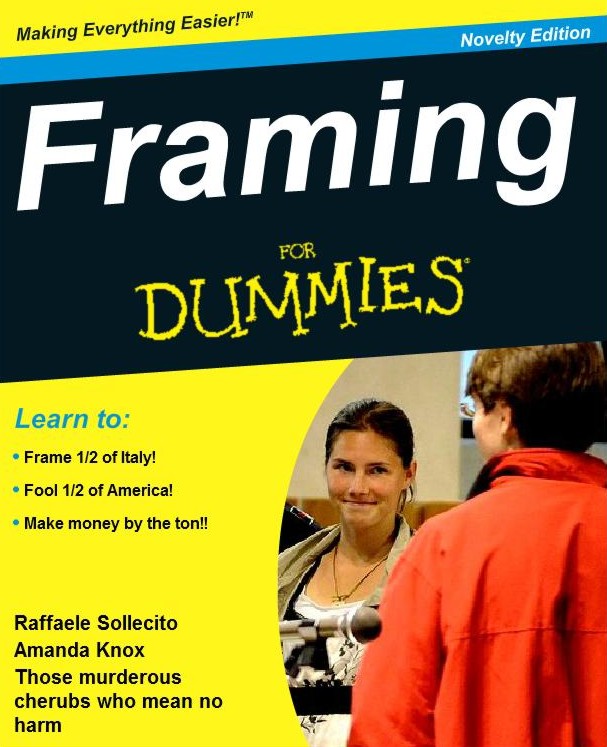
Monday, April 07, 2014
Italy Pushes Back On False Claims In Sollecito Book: 20 Examples Of What He Must Defend In Court
Posted by Our Main Posters
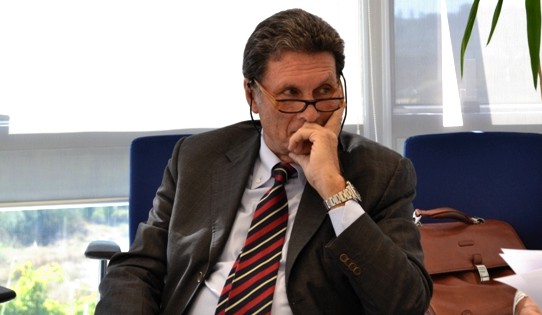
[Florence prosecutor Gianbartolomei will announce RS charges later this month]
Many posters contributed to this analysis and to what is to come. Special thanks to James Raper and Sara, and also to Vivianna, Yummi and Kermit.
1. Sollecito’s blood-money book gets published
Sollecito’s hapless book Honor Bound was released in English on 18 September 2012.
Within ten days all of Italy knew that the book was a crock.
Bruno Vespa, the persistent host of Porta a Porta, Italy’s most popular crime show (for the equivalent of which American TV cries out) forced Sollecito’s father in national prime-time to admit that at the core of the book was a huge lie.
Other claims about the case and the officials were shown to be wrong too.
Smarter people than Sollecito’s help in the US (Andrew Gumbel and Sharlene Martin, later John Q Kelly, and Simon & Schuster) might have put the brakes on until they got the truth straight and a revised version out.
But no, a media blitz was all ready to roar. The blood-money couldn’t wait.
Huge numbers of professional book reviews and Amazon reader reviews swallowed Sollecito’s claims in the book whole. The nastiness toward Italy and its justice system and officials was ratcheted onto a whole new plane.
2. Needless to say, official Italy did take note
For the legal reasons explained in this key post an investigation by the Florence Chief Prosecutor’s Office was mandated to begin.
In that same post it was warned that for the period the investigation would require, it would be taken below the radar, so that the Sollecito defense team would have no way to respond through dishonest PR or legal dirty tricks.
A not-unsurprising result of that stealth move was that in the meantime, in the last year, very full of themselves and feeling no constraint, Sollecito and his team went hog-wild in adding more crazy claims. And still more.
3. Now the investigation is complete
Now Prosecutor Gianbartolomei has issued his announcement of the conclusion of his investigation. The content of the notice is at present confidential except to the defenses.
As Yummi reports, from this point on, the defense has 20 days to say something, such as to request that Sollecito be interrogated or allowed to declare or explain something.
Then the prosecution will file charges against Sollecito and Gumbel, and possibly Sharlene Martin and Simon & Schuster, their careless publishers in New York.
Which precise false claims Prosecutor Gianbartolomei has made the target of his report we do not know. But this is a target-rich environment, that is for sure:
Consider for starters these 20 false claims which, believe it or not, all appear in the first seven pages of the book.
4. Twenty False Sollecito Claims
1. That Italian justice authorities took the easy way out
This is the story of two ordinary people who stumbled upon an extraordinary circumstance, the brutal murder of a British student in Italy. Neither Amanda Knox nor I had anything to do with the crime, but we came perilously close to spending the rest of our lives in prison because the authorities found it easier, and more convenient, to take advantage of our youth and inexperience than to mount a proper investigation. It’s that simple. And that absurd.
No advantage was taken of them. The two stood out very sharply from all the others of similar age, and of similar inexperience (whatever that means). They did and said dozens of things in the early days that set them sharply apart.
They were interrogated quite fairly, the Italian media was not especially hard, Dr Mignini never ever leaked, and they had lawyers and family handy at every turn after they were arrested. They each gave the authorities less than zero help - they tried to lead them off on wild goose chases, for example the false claim AK made against Patrick and dozens of other false claims, and apparently tried to finger yet another north African, Hicham Khiri, in a conversation they clearly knew was being recorded.
A “proper” investigation was indeed done. Simply read through all the posts on the trial here in the first half of 2009, and the prosecutor’s excellent summations, and you will see what a smooth comprehensive job was done. And the Supreme Court concluded that THREE had to have been involved, from the recreation of the attack and all the wounds on Meredith’s body. AK and RS and their lawyers never came within light-years of throwing real suspicion on anyone else.
2. That the preventive custody was very harsh
On November 1, 2007, Amanda and I were carefree students at the beginning of a cross-cultural love affair in a beautiful Umbrian hill town. Within days, we were thrown into solitary confinement in a filthy prison, without access to lawyers or loved ones, accused of acts so heinous and disturbing we may never be able to banish them from our thoughts, or our nightmares.
Raffaele was sent to preventative prison on Tuesday November 6. Capanne Prison was almost brand-new then, and far from crowded. Cells contain TVs and private bathrooms.
All questioning had been stopped early on 6 November until Sollecito could have a lawyer present. He himself wrote to his father in his “prison diary” on November 7: “I may see you tomorrow, at least that is what I was told by Tiziano [Tiziano Tedeschi, his lawyer at the time], who I saw today and who defended me before the judge.”
Mr Tedeschi made no complaint about any delay in the first meeting with his new client. In Italy, a judge must determine within 48 hours whether to hold or release detained suspects. Judge Matteini did so meticulously and refused his release.
3. That the prosecution and Italian media demonized the pair
In the newspapers and on the nightly news, we were turned into monsters, grotesque distortions of our true selves. It did not matter how thin the evidence was, or how quickly it became apparent that the culprit was someone else entirely. Our guilt was presumed, and everything the prosecution did and fed to the media stemmed from that false premise.
In the real world, the prosecution fed nothing at all secretly to the media and publicly very little, none of it self-servingly biased. Italian reporting was sporadic and very mild compared to anything one can see said daily about possible perps in the US and UK newspapers and on US TV. Besides, any coverage, which was in part deliberate in the situation as dozens of students were fleeing Perugia, had no influence on anything, neither on the investigation nor the trial.
The Italian system is set up so media can have less influence than almost any other media on any other justice system in the world. The Micheli and Massei sentencing reports show the judges were not unduly influenced even by the lawyers right in front of them, let alone by mild media reports 1 or 2 years before that.
4. That four years were wasted showing where the prosecution went wrong.
By the time we had dismantled the case and demonstrated its breathtaking absurdity [in the annulled Hellmann appeal] we had spent four of what should have been the best years of our lives behind bars.
“We” meaning the defense lawyers did very little in the annulled Hellmann appeal that they hadn’t flailed uselessly against in the trial. Except of course maybe shopping for an inexperience and pliable judge, and for DNA consultants who they could then spoon-feed. Much of the hard evidence they simply kept well away from in the trial and annulled appeal. Such as the extensive evidence in the corridor and bathroom and Filomena’s room, which were all considered parts of the crime scene.
On the other hand, RS’s claim could well apply to what Dr Galati and Cassation did for the Hellman sentencing report. Dismantled the appeal verdict, and demonstrated its breathtaking absurdity.
5. That Knox was made a target because timid Italy was scared of her.
Amanda and I certainly made our share of mistakes. At the beginning we were too trusting, spoke too frivolously and too soon, and remained oblivious to the danger we were courting even after the judicial noose began to tighten. Amanda behaved in ways that were culturally baffling to many Italians and attracted a torrent of gossip and criticism.
An inaccurate and xenophobic remark originated by the American Nina Burleigh, who was having severe culture shock of her own and surrounded only by other foreigners with similar mindsets. What EXACTLY was so baffling about Knox to the very hip Italians? That Knox was pushy, obnoxious, humorless, rather lazy, rather grubby, and not especially bright or funny or pretty? That she put off Patrick, Meredith, her other flatmates, the boys downstairs, the customers in the bar, and just about everybody else except for the distasteful druggie loner Sollecito?
Read this post by the Italian-American Nicki in Milan. To quote from it “As many of us were expecting, Amanda’s testimony has backfired. She came across not as confident but arrogant, not as sweet but testy, not as true but a fake who has memorized a script, an actress who is playing a part but not well enough to fool the public….. Amanda Knox is not on trial because she is American and therefore too “emancipated”....Italians don’t much like Amanda primarily because they perceive her as a manipulative liar, who is suspected of having committed a heinous crime for which there is a whole stack of evidence.”
6. That Knox and Meredith were really great, great friends.
We were young and naive, unthinking and a little reckless. Of that much we were guilty. But what we did not do””and could not have done, as the evidence clearly showed””was murder Meredith Kercher.
Meredith was Amanda’s friend, a fellow English speaker in the house they shared with two Italian women just outside Perugia’s ancient city walls. She was twenty-one years old, intelligent, and beautiful. She and Amanda knew each other for a little over three weeks, long enough to feel their way into their new surroundings and appreciate each other’s interests and temperaments. I never heard about a single tense moment between them.
Plenty of other people did know of tensions. Meredith’s family and friends all knew Meredith was finding the noisy dirty lazy loud unfocused Knox and her one-night-stands hard to take. Her other flatmates found her hard to take. Her employer Patrick found her hard to take. His customers in the bar found her hard to take. The Lifetime movie got this strident angle pretty straight.
Remember, Meredith enrolled for a full academic load at the main university. Knox in sharp contrast took only one undemanding language course - which anyone could walk into - requiring maybe 10 hours of study a week. They increasingly did less together. In fact after several weeks nobody was lining up to have anything to do with Amanda Knox.
Seemingly unable to reverse herself, she was headed to being among the least popular of students in Perugia. It should be recalled that the callous remarks by Amanda Knox about the death of her so-called friend Meredith included “Shit happens”, “She fucking bled to death”, and “‘I want to get on with the rest of my life”.
7. That an intruder knew about the rent money and so murder ensued.
Meredith, of course, suffered infinitely worse luck than we did: she came home, alone, on an ordinary Thursday night and had her throat slit by an intruder hoping to steal the household rent money.
There is zero evidence that this was the case. Knox herself ended up with a similar amount of cash that she has never been able to explain. There is zero possibility that Guede would know that any money was lying around - or not lying around, as it was concealed in Meredith’s drawer.
And take a look at the many images of the brightly lit house at night. There are several dozen other houses behind it in the dark which any smart burglar would have chosen first. In 2008 two real break-ins occurred at the house - both were in the dark behind the house, which is by far the easiest place to break in.
So much for the spurious lone-wolf theory, which Judge Micheli first ruled out even before trial.
8. That the media got hysterical and portrayed heartless killers.
But the roles could easily have been reversed. If Meredith’s Italian boyfriend had not gone away for the weekend and if Amanda had not started sleeping over at my house, she””not Meredith””might have been the one found in a pool of blood on her bedroom floor. That reality was quickly lost amid the hysteria of the media coverage. But it continued to hover over both of us””Amanda especially””as we sank into the legal quagmire and struggled in vain to overcome the public image of us as heartless killers.
There was zero media hysteria. This silly claim was addressed above. Watch the Porta a Porta YouTubes and dozens of other Italian reports and try to find ONE that is not fair and cautious and mature.
How precisely did the two struggle in vain to overcome their public image? By coming up repeatedly with stories which didnt even tally with others of their own, let alone with one another’s? They never between them made even one helpful statement which actually helped the police. And even their respective parents strongly suspected or knew of their guilt and were all caught incriminatingly on tape.
9. That Rudy Guede did it alone; ignore vast evidence that proves not.
This should not have been a complicated case. The intruder was quickly identified as Rudy Guede, an African immigrant living in Perugia with a history of break-ins and petty crimes. His DNA was found all over Meredith’s room, and footprints made in her blood were found to match his shoes. Everything at the crime scene pointed to a lone assailant, and a single weapon. Guede repeatedly broke into houses by throwing a rock through a window, as happened here, and he had been caught by the authorities in the past with a knife similar to the one that inflicted Meredith’s fatal wounds.
This is laughable. It has in fact been demonstrated in numerous ways that the attack involved multiple assailants and this was accepted by the Supreme Court.
Sollecito’s own lawyers never forcefully argued this. They produced two non-credible witnesses in the appeal trial (Alessi and Aviello) to actually prove that Guede had some other accomplices or that several others did it. Also Amanda Knox if anything diverted attention AWAY from Guede as he did in turn from her. He wasn’t quickly identified precisely because Knox had rather credibly fingered Patrick.
There is no proof Guede was an intruder. The trial court concluded Knox invited him in. Guede had zero proven history of break-ins or petty crimes or drug-dealing, and late in 2008 at his trial Judge Micheli became angry at such claims. Guede had no prior criminal record at all. He had only been back in Perugia for a few weeks, after an extended stay up north. His DNA was not found “all over” Meredith’s room. A major surprise, in fact, was how few traces of him were found.
The recreation of the crime scene and the autopsy both pointed AWAY FROM a lone assailant, not toward. From Meredith’s wounds, it was quite evident that two and perhaps three knives had been used, and not a single weapon. What lone intruder carries or uses two or three knives? And footprints in blood outside the door matched the feet of both RS and AK. This is why the Supreme Court confirmed Guede’s guilt only “in concorso” (with others).
10. That the cops could have caught Guede fast, despite Knox’s frame
Guede did not call the police, as Amanda and I did, or volunteer information, or agree to hours of questioning whenever asked. Rather, he fled to Germany as soon as the investigation began and stayed there until his arrest two and a half weeks later.
Guede’s apprehension and eventual conviction on murder charges should have been the end of the story. But by the time Guede was identified, the police and the public prosecutor’s office had convinced themselves that the murder was, incredibly, the result of a sexual orgy gone wrong, in which Amanda and I had played leading roles. Their speculations ignited a media firestorm, inspiring sensationalist headlines across the world about the evil lurking behind our seemingly innocent faces.
The authorities had no shred of evidence to substantiate this story line, only erroneous suppositions and wild imaginings. We had an alibi for the most likely time of death, and none of the initial forensic evidence tied us to the scene of the crime. Nothing in our backgrounds gave any hint of a propensity for violence or criminality. We were both accomplished, hardworking students known to our friends and families for our gentleness and even tempers.
Four more untrue remarks. All three were convicted of a murder with a sex-crime element and nobody was wrongly “convinced”. Which alibi is Sollecito talking about now? He himself admits in chapter 1 (Love and Death) that they had no “real alibi”. They still have no alibis at all for the second half of the evening, neither of them, when Meredith’s murder indisputably occurred.
Extensive forensic evidence within days tied them both to the scene. Not a single element of it has been discredited in the eyes of the Massei trial and Nencini appeal court. Not even one. Nothing was falsified.
Neither of their backgrounds was squeaky clean. Both had long been into illegal drugs, the loner Sollecito had to be watched by his father and teachers, the increasingly disliked Knox had a history of doing and saying crass off-putting things. Both were lagging behind their brighter peers in their studies and Knox was taking a year off.
11. That the prosecution fed the media a huge number of false claims.
Yet the authorities stuck to their guns. They fed the media a steady diet of sensationalist stories of how Amanda, the promiscuous American she-devil, and I, her sex-and-drug-addled Italian helpmeet, had tried without success to drag Meredith into our depravity and punished her by plunging an outsize kitchen knife into her neck.
Complete fiction. Again, in the real world, as the media reporters all confirm, the prosecution fed nothing at all secretly to the media, and publicly very little, none of it self-servingly biased.
Italian reporting was sporadic and very mild compared to anything one can see daily on possible perps in the US and UK newspapers and on US TV crime shows. There is zero sign this mild coverage mattered to the courts. As the media reporters all confirm, they were fed next to nothing by the police or prosecution on the case,
But whereas Mr Mignini famously never leaks, the defenses are widely claimed to have leaked throughout like sieves. So did Sollecito’s own family - they leaked an evidence video to Telenorba TV, for which they were considered for trial. Even we at TJMK and PMF received several offers of juicy leaks. Here is one example of where the Knox forces leaked - wrongly in fact - and then nastily slimed the prosecution and defenseless prison staff.
12. That the authorities had lots and lots and lots of scenarios.
It might have been funny if the consequences had not been so devastating. Listening to the tortured language of the prosecution””“one can hypothesize that . . . ,” “it is possible that . . . ,” “one can imagine that . . . ,” “this scenario is not incompatible with . . .”””it became clear that the authorities, like the media, were treating our case with the bizarre levity of an after-dinner game of Clue, or an Agatha Christie mystery. Everyone, even the judges in their black robes, had theories they were itching to air.
Have Sollecito and Gumbel ever before been in any other court in Italy or the UK or the US? Every judge and/or jury has to arrive at a scenario on lines not unlike this. That is the whole POINT of having courts - to weight the probabilities in what happened in the crime. The only difference in Italy is that the judges have to think their verdict through for weeks, and then write it all out, and then see it scrutinized by a higher court. This is hardly a requirement to be sneered at.
Gumble and Sollecito should have studied how US and UK juries arrive at their own scenarios. Very few US and UK lawyers think they do a better job. Ask those who watched the OJ Simpson and Casey Anthony trials and bitterly criticised the outcomes. And Italy has a vastly lower rate of false imprisonment than the US does.
13. That Italy is a medieval country with a primitive justice system.
It could have been Colonel Mustard in the drawing room with the revolver; instead it was Amanda and Raffaele in the bedroom with the kitchen knife. How was it conceivable that a democratic country known for its style and beauty and effortless charm””the Italy of the Renaissance and la dolce vita””could allow two young people to be catapulted to international notoriety and convicted of a horrific crime on the basis of nothing at all?
This is not remotely what happened. There was very far from nothing at all. Convictions in the US and UK regularly result based on evidence 1/10 or 1/100 of that here - sometimes from one single evidence point. Any one or several of maybe 100 evidence points here could have convicted them in a US or UK court.
Italy gives defendants every possible break, and the justice system is seriously loaded against victims and their families. Read here and here.
14. That the prosecutors office and media were in a grim embrace.
The answer has something to do with the grim embrace that developed between the prosecutor’s office and the sensationalist media. Like addicts constantly looking for the next fix, each fed the other’s insatiable appetite for titillation and attention. The casual cruelty of “Foxy Knoxy” and her Italian lover became too good a story line to abandon, even when it became apparent it was overheated and unsustainable. Our suffering was the price to be paid for the world’s continuing entertainment.
WHAT grim embrace? WHAT addicts? WHAT fix? WHAT insatiable appetite? WHAT titillation and attention? This is clearly defamatory if it can’t be proven, and we can turn up no evidence that any of it is true. It has to be one of the most foolish lies in the entire book, it is so easy to disprove. These who are being accused of crimes here are career police and prosecutors secure in their jobs, and none have the slightest gain to make from false convictions.
15. That in the justice system speculation and hearsay run rampant
The meandering complexities of the Italian legal system, where speculation and hearsay are allowed to run rampant and time invariably slows to a maddening trickle, did little to help our cause.
Total mischaracterization. First note that by comparison with any country in the world THERE IS NOT MUCH CRIME IN ITALY. There is some minor corruption and still some minor mafia action, but thefts and burglaries and assaults are few and murders even fewer. The main crime if you can call it such is not lining up to pay taxes. Italy’s murder rate is 1/6 that of the United States and its prison incarceration rate is 1/30 that of the United States, so where IS all this crime about which the claimed speculation and hearsay are running rampant?
The legal process could have been fully over by the end of 2009 if (1) there was not the entitlement to two automatic appeals; in UK and US terms there was very little to appeal about; and (2) the Hellmann appeal court had not been fixed to produce a corrupt outcome, as the displaced judge Sergio Matteini Chiari and Cassation and the Council of Magistrates have all made plain.
And compared to American police and prosecutors, their Italian counterparts are famously taciturn under their unusually firm rules. There is media interest, for sure, as there should be when there are crimes, but that also is comparatively restrained. Watch the various Porta a Porta shows on YouTube and you will see how sedate crime discussion tends to be.
The Constitution and judicial code set out to achieve the exact opposite of speculation and hearsay affecting justice, and they do so. Creating this restraint is a primary reason for the judges’ sentencing reports and all the magistrates’ checks of investigations along the way.
This whole series of dishonest claims about the the Italian system in the preface of the book and in a later chapter have clearly not been read through or okayed by even a single Italian lawyer.
16. That in Italy proof beyond a reasonable doubt scarcely exists
For reasons deeply embedded in the country’s history, the concept of proof beyond a reasonable doubt scarcely exists in Italy, and the very notion of undisputed fact is viewed with suspicion, if not outright aversion.
So Gumbel and Sollecito are historians and legal experts now? It would be nice, wouldn’t it, if either were able to explain the remark. This may be an ignorant swipe at the Napoleonic Code on which the law of a lot of continental Europe is based. Ignored is that Italy carried out its own reforms to the Code in 1990 and more subsequently. Much of that reform, it should be pointed out, was procedural or structural rather than substantive law.
There are two things wrong with “..the concept of reasonable doubt scarcely exists in Italy.”
1. It is factually wrong. Italian jurists, the courts, and so on, are well acquainted with the concept as it has been a fundamental aspect of criminal proceedings in Italy as elsewhere for many decades if not centuries.
2. It suggests that Italians are not intelligent enough to understand the concept anyway. That of course is an insult to Italians. Actually they are no less intelligent than the rest of us elsewhere who strive to understand it.
Until the 1990 Reforms the relationship between criminal and civil proceedings in Italy were governed by the principles of unity of jurisdiction and the prevailing status of criminal proceedings. Hence, if the facts were the same then criminal proceedings (to punish the guilty) and civil proceedings (to render liable the guilty for damages) were heard at the same time and still sometimes are, as in the Meredith Kercher case.
What has changed (relevant to the above quote) is that civil cases can be and are more likely to be heard independently from the related criminal cases and, where not, the standard of proof in civil cases (the preponderance of evidence or, as we usually refer to it, the balance of probabilities) is to be applied to the civil case, and the civil case only, rather than be confused with or overriden by the criminal standard of proof (beyond reasonable doubt).
Not an easy task, admittedly, to apply different standards to different tasks, based on the same facts, in the same proceedings, but Italian judges are trained to do this because that is their system. No judge would EVER confuse “beyond reasonable doubt” with “the balance of probabilities” when the issue at stake is depriving an individual of his freedom.
17. That the Italian judiciary has vast, unfettered powers
Few in Italian society wield as much unfettered power as the robed members of the judiciary, whose independence makes them answerable to nobody but themselves.
Radically the opposite of the truth. The paranoid claim reads like it came from ex PM Berlusconi fearful of his own conviction or one of his parliamentary lackeys such as Girlanda.
The checks and balances on judges in the Italian system are enormous, perhaps the toughest checks and balances in the world. Read here and here about them.
All of the best judges in the world are independent and they all follow a demanding career path, not elected (as ex-Judge Heavey was) under zero criteria, or appointed under the political sway of politicians. We wonder if Gumbel and Sollecito have ever heard of the US Supreme Court? Do those judges answer to anybody? No? How unfettered.
18. That the courts are the most reviled institution in Italy.
Many Italians retain a healthy skepticism about the reliability of their procedures and rulings. The courts””tainted by politics, clubbishness, pomposity, and excruciating delays””are the most reviled institution in the country.
As our Sollecito Book pages make clear again and again and again, the Italian system is remarkably NOT tainted by politics, as even the most surperficial watcher of the trials of ex Prime Minister Sylvio Berlusconi would know.
And on the issue of popularity we have previously posted this and this and also this.
Our Italian poster Machiavelli (Yummi), who posted our deep analysis of the appeal to the Supreme Court by Dr Galati, has provided these hard facts:
For comparison, in 2011 the percentage of Italians who declared they trust the justice system “a lot” or “enough” was 53.3%. By comparison, the percentage of Italians who declared they trust the government “a lot” or “enough” were 14.7%, and those who trust the parliament were only 15%.
In 2012, the percentage of Italians who trust the parliament is now only 9.5%, and those who trust the Mario Monti administration are only 21.1%.
Over the eight years from 2004 to 2012 the percentage of Italians who trust the justice system was always bigger than those who trust parliament or government by at least ten points, and in some years we can see a spread of 20, 30, even 39 percentage points achieved by the judiciary over the parliament and government.
However, some cases of corruption (such as our Hellmann-Zanetti case, but also several others indicated by the Rapporto Italia 2012) do hamper trust.
The most trusted institutions in Italy above all are the Carabinieri (74% of Italians trust them) and the Polizia di Stato (71%).
Which means the most trusted institutions are precisely those law enforcement instruments which are deployed to enforce the orders of prosecutors.
19. That prosecutors can spin their cases into any shape they please.
Because the Italian legal system is almost completely blind to precedent and relies on a tangle of impenetrable codes and procedures, prosecutors and judges have almost boundless freedom to spin their cases into any shape they please and create legal justifications on the fly. Often, they are more interested in constructing compelling narratives than in building up the evidence piece by piece, a task considered too prosaic and painstaking to be really interesting.
Whoever wrote this either wasnt an Italian or a lawyer, and either way didnt have much of a clue. The entire Italian system under the post WWII constitution was designed to PREVENT what Sollecito & Gumbel claim it allows here.
There are checks and balances and reviews every step of the way. Magistrates (initially Matteini here) determine what a prosecutor may do in developing and presenting a case. Parties may appeal to the Supreme Court AT ANY TIME as Knox’s lawyers did over her second written confession - which she herself had demanded to make in front of Dr Mignini after he finished warning her of her rights.
Hard for Sollecito & Gumbel to believe, perhaps, but the defense is actually present in the same courtroom. They can raise points of order at any time. So can the defendants themselves, at any time, something maybe unique in the world.
And judges actually have minds of their own. And then there are the unique written sentencing reports, and the two automatic appeals if any parties want to pursue them.
Sollecito & Gumbel should have read the 2012 Galati appeal more closely. The Prosecution’s Appeal To The Supreme Court is available in English here. Precedent has a section to itself - “The non-observance of the principles of law dictated by the Cassation Court in the matter of circumstantial cases (Article 606(b)) in relation to Article 192 paragraph 2 Criminal Procedure Code.”
Well, that’s precedent, via the Court of Cassation no less! How surprising from Gumbel/Sollecito that they should make that claim about ignoring precedent when in fact there it is, going right to the heart of the flawed Hellmann/Zanetti judgement on circumstantial evidence! What else is a Code but in effect a codification, a gathering together, a rationalisation, of best law - and precedent?
There is an absurd irony here, were they aware of it. Perhaps they are. Surely it is Hellmann and Zanetti who have displayed “a boundless freedom” in spinning the case “into any shape they please”, and who have “created legal justifications on the fly”? As for prosecutors doing this, at least Dr Mignini followed the evidence, and American readers may recall the infamous Jim Garrison, the DA hero of Oliver Stone’s movie “JFK” but who in reality, unlike Dr Mignini, was a total and utter crackpot.
And what issue exploded the Porta a Porta TV show in Italy in September 2012? It was Sollecito’s false claim that the prosecution had secretly tried to offer him a deal if he would roll over on Knox. NOBODY including his own father and his own lawyers confirmed him. Evidence against both was overwhelming. Nobody needed such a deal, and Italian prosecutors are highly rules-bound against ever offering such deals.
Sollecito was in effect accusing Dr Mignini of a felony with this much-repeated false claim in his book. (In her book Knox also accused Dr Mignini of a felony.)
20. That the prosecutors and judges in Italy are far too close.
Prosecutors and judges are not independent of each other, as they are in Britain or the United States, but belong to the same professional body of magistrates. So a certain coziness between them is inevitable, especially in smaller jurisdictions like Perugia.
Yes, prosecutors and judges in Italy belong to the same professional body of magistrates. But then so does the defense lawyer Ms Bongiorno. The claim that there is no independence between prosecutors and judges in Italy, in fact a coziness between them, is a bit rich.
Consider, say, the UK. It is true cases are prosecuted by the Crown Prosecution Service, a government body, but in serious cases the CPS will employ barristers from the Inns of Court. There is scarcely a judge in the UK, even up to the highest level, who was not and who is not still a member of one of the Inns of Court from whence barristers, for the prosecution or for the defence, ply their trade.
You can’t walk past an Inn without seeing the names of judges on the roll call on the plaques outside. A judge is still a barrister, just fulfilling a different function, although, of course, now paid by the State. The old school boy tie? Corruption? No, the fulfilling of different roles by members of the same body is called professionalism.
Judges and lawyers all belong to the American Bar Association in the US and attend the same conferences. No sign that this lack of “independence” ever affects trials. This claimed excess of coziness is often ranted about online by the Knoxophile David Anderson who lives near Perugia. Nobody who pays him any attention can get where he derives this from. Maybe he heard it from Hellman?
Perugia prosecutors and magistrates are all known to do a fine job, and the national Olympics & earthquake relief cases involving powerful Rome politicians were assigned for competent handling to where? To Perugia… Defense lawyer Ghirga and Prosecutor Mignini have the reputation of being good friends. And Mignini and Massei would both draw their salaries from the State. But so what? Do not judges and DAs in the the USA do likewise? Are Gumbel and Sollecito impugning the professionalism of the counterparts of Mignini and Massei all over the world? It sure reads like it.
5. About Relevant Forthcoming Postings
Akk of this above analyzes only the first seven pages, out of a book which has several hundred pages. We will post one or two times more during April. Later in the book, there is a lot of venomous sneering addressed at Dr Mignini, although his performance at trial was excellent - and he is now for Perugia’s region (Umbria) the Deputy Prosecutor General.
In Italy Dr Mignini is now and then on national TV along with Michele Giuttari, who pursued the main Monster of Florence theory - not the crackpot theory Preston and Spezi attempted to use to frame someone. At impugning him, Sollecito and Gumbel have failed miserably, and for that are now in the crosshairs of the system.
*******
Many posters contributed to this analysis and to what is to come. Special thanks to James Raper and Sara, and also to Vivianna and Kermit.
[Kermit’s take on Katie Couric, one of several smart TV hosts who suspected a giant con]

Friday, April 04, 2014
The Florence Chief Prosecutor’s Office Announces That Sollecito Will Face More Court Action
Posted by Our Main Posters
Breaking news from Main Poster Yummi
Prosecutor Gianbartolomei has issued a notice about the conclusion of his investigation. The content of the notice is confidential for the defenses.
From this point the defense has 20 days to say something, like to request that the defendant (Sollecito) is interrogated or has anything to declare, or to submit any documents if they want to.
Then, once the 20 days are expired, the prosecution will file charges.
Since the charges will include almost certainly, beyond aggravated defamation, also contempt of the Judicial organs, the prosecution may send a notice to the Ministry of Justice too.
Since they are victims of contempt they may appoint a plaintiff.
The senior Florence prosecutor Dr Giuliano Giambartolomei was assigned to investigate the claims in Sollecito’s “Honor Bound”.
Today he announces that his findings indicate that many claims are spurious and justify new charges being brought against Sollecito. Shadow-writer Andrew Gumbel, who recently published this self-incriminatory rant has also been named.
When the charges are filed several or some others who have been assiduously “helping” Sollecito (mostly for big bucks) such as book-agent Sharlene Martin might find themselves named also
So Sollecito for sure and Knox most probably will be confronting the often-contradictory claims in their books, and saying whether they accept or reject each of them, which should put other book-writers who made false claims on the spot and maybe wind the whole FOA effort down.
We will be making our separate page on Sollecito’s various false claims live again. Main posters have posted a large number of corrections to Sollcito’s claims in the book. We have been putting them in correct page-order.
Miriam has kindly contributed this translation of today’s report in Il Messagero. Dr Giambartolomei only hints to the reporter what will be in his report which will quote all the passages in full for which Sollecito will have to account.
Raffaele Sollecito Insults The PM And A New Trial Starts
As always everything [possible] is presumed and as always, in the case of the murder of Meredith Kercher, everything [possible] can be overturned at every verdict.
Even in the associated trials, such as the one for defamation (against PM Mignini) and contempt (against the police) for which Raffaele Sollecito, found guilty of the murder of Meredith Kercher along with his ex-girlfriend Amanda Knox, is being investigated along with the British journalist-author (now in absentia) Andrew Paul Gumbel.
Defamation, because many parts of the book “Honor Bound”, of which both are authors, contains for the prosecution various ignominious remarks.
More than simple phrases, entire chapters (allegedly) of the book are written in what is technically called “conclusione delle indagini” and requires the matter to be brought to justice, and therefore to trial.
[The book] starts by summarizing the main evidence (that was then proved to be wrong by the facts) against Sollecito.
The two being investigated write: “ the main proof that Mignini had to bring to the preliminary hearing were my Nikes… and he did everything possible to render them more incriminating…”
Then again “the police had only the pictures of my shoes (not those of the print) and in some way they came to the conclusion that my Nikes were the same brand, model and size as the shoeprints on the floor of Meredith’s apartment. There was no doubt about this”
Then the facts demonstrated that the shoe prints where of Rudy Guede, the third person condemned for the murder of the British student, and could not be those of Sollecito, because of the size.
Therefore this touches on the management of the trial on the part of Mignini. Sollecito-Gumbel write: “one of the reasons that our hearings were so distant one from the other was that Mignini was fighting his own separate legal battle for abuse of investigated activity.”
This connection goes to the case of the death of the Perugian Doctor Franceco Narducci, connected to the Monster of Florence case which Mignini had investigated.
Sollectito sustains: (defended in this case by Alfredo Brizioli) “I think our case, among other things, was a big diversion to keep the media’s attention away from the legal battle Mignini was having in Florence, and to give him the victory in a high profile case he so desperately needed to restore his reputation.”
The young Pugliese continues: “”¦..just as he did in the Monster of Florence case, Mignini used every instrument at his disposal against his critics and adversaries. The avalanches of legal action by part of Mignini had an inevitable icy effect , especially on the Italian press and this played a clear role in turning the public opinion against us.”
The charges against Sollecito and Gumbel are those of having sustained that it was Mignini’s idea to seek to obstruct the investigation as is from the beginning, it was a studied act to bend the investigation and turn the trial to his side.”
This is a clear accusation in the eyes of the prosecutor Giuliano Giambartolomei: “His approach (Mignini’s), Sollecito is saying, was particularly vindictive…. This is enough for Sollecito to face charges of defamation.”
Important to note that Dr Giambartolomei does NOT explain here precisely what will be in his report. That will have to quote all the passages in full for which Sollecito may have to account. Then he or whatever prosecutor charges Sollecito will go to another depth.
With our analysis of the book and knowledge of Italian law we can probably pick many or most of the false claims made which impugn officals or the Italian system.
More posts coming. Stay tuned.
Friday, February 28, 2014
What We Might Read Into Sollecito Lawyer Giulia Bongiornos Final Arguments To The Appeal Judges
Posted by Machiavelli
Under the table & over the top
The picture of a serene-looking Giulia Bongiorno waving a couple of knives in court on 9 January may be visual inspiration to this reflection about what we can understand from the structure and content of her closing arguments.
A very peculiar feature of her arguments was the desperate opening, suggesting to put the investigation ““ and the whole justice proceedings ““ on trial.
The introductive topic of her speech is a quote from a book by Alessandro Satta, a narrative description of the riotous irruption of the mob inside the Revolutionary Tribunal hearing room on Sep. 2. 1792, the defendants are the some of the King’s Swiss guards.
The passage by Satta describes the “horrendous” vision of a hord of sanculots slowly gathering outside the court, Bongiorno compares that to the angry mob in Perugia after the first appeal verdict.
But if you read the same text by Satta a little further, a few lines beyond the snippet Bongiorno was reading, the narration goes on describing how sanculots manage to enter the courtroom, in a force of hundreds ready to lynch the defendants, but they are suddenly halted by an authoritative order of the Judge, and they unexpectedly obey.
Just after that, Satta drops in an explanatory quote from the book Le Tribunal révolutionnaire (by historian Lenotre) saying: “the people understood that these highly educated individuals in black robes would have gone on with the action started by the hords, and they would accomplish it more perfectly”.
It seems like Bongiorno opened her speech with an implicit depiction of the judges and magistrates of Perugia as kind of Jacobin extremists whose task is to “legitimize” the vindictive fury of a pitchforks mob.
The quote she read did not include Satta’s conclusive lines, so that the consequent thought about the judges’ role remained unexpressed and in the background.
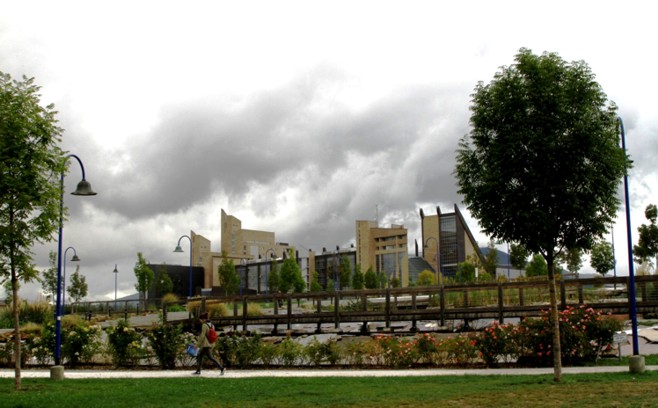
(Photo by Machiavelli_Aki)
A side note about Bongiorno’s arguments: in fact I had the feeling that allusion to implicit subtexts was something that belonged to her speech as a method or a style, it marked the whole of her arguments. You may recall Wittgenstein’s dictum “This work consists of two part, what is written in it, and what is not written in it. The latter is the most important part.”
Such a motto might be apt to address the major feature of Bongiorno’s defensive argument, insofar as she conveyed that something that “couldn’t be talked about openly” was there and that was probably a main argument.
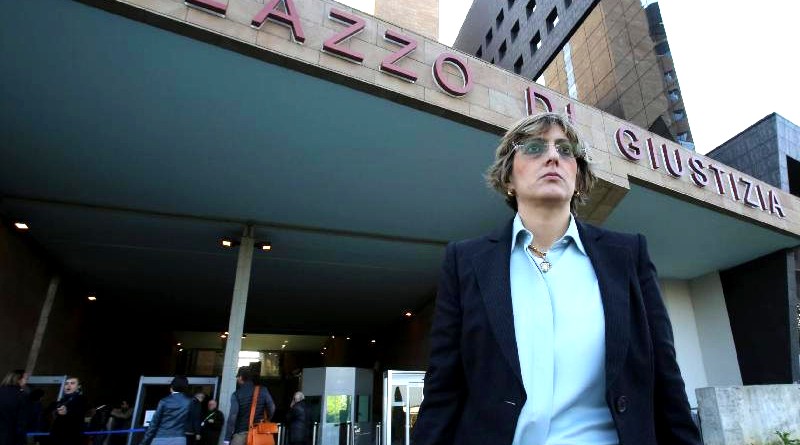
(photo by Ansa)
At first, as I said, she went through a brief emotional recollection of her moments while in Perugia surrounded by a raging mob, and then she unfolded the rest of her introductive section.
The purpose of this bit of revolutionary narrative first juxtaposing the Perugian citizens to Sanculots and the judges to Jacobins, and then, immediately following, a series of accessory arguments all encompassed by an introductive function, all this was clearly intended to set a framework thesis meant to work as a basis for the structure of the whole defensive arguments.
It is in fact a peculiar structure, apparently entirely resting upon one, single elaborate premise.
The thesis she places at the foundation of the entire defensive argumentation is the following: the trial as a whole, as much as its outcome, had been somehow determined and “tainted” from the beginning by events which occurred within a very short framework of time, in the very early days of the investigation, the weeks around the time of the suspects’ arrests.
Bongiorno suggested that only this “short period” ““ the early days of November 2007 - is what matters and the only topic worth of a defence analysis; since this was the time frame within which - according to Bongiorno - everything was decided, this was the time when some “errors” in the investigation occurred, before the point when a veil of prejudice and hatred fell upon people’s hearts and minds like kind of black curtain, preventing from that moment on any fair or rational judgement.
Aggressive Digressions
After the quoting of Satta’s speech, she develops her introduction for a while, branching out into some political-sociological speculations (such as that authorities chose the crime scenario that was most reassuring for the population) as well as some political-anthropological consideration (like the theory that free spirited women are seen as suspicious as a consequence of women empowerment movements).
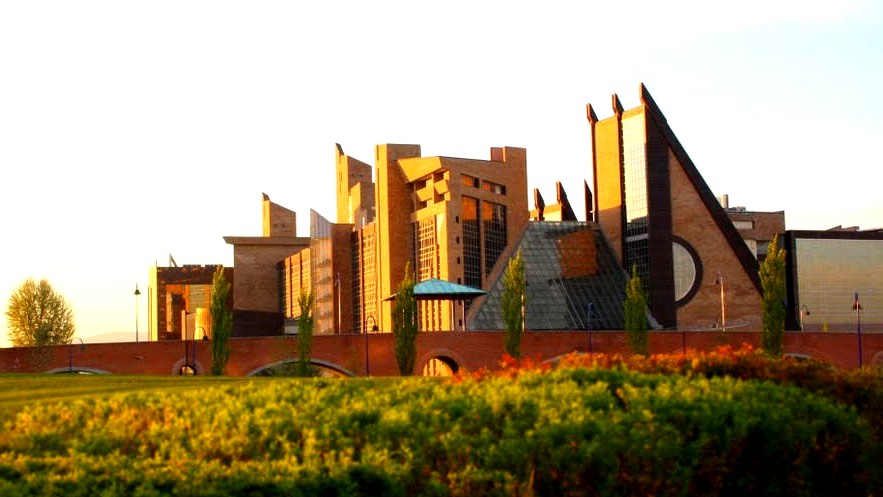
(Palace of Justice of Florence ““ photo by FrederickStudio)
A speech opening as did Bongiorno’s, that is, relying on a set of over-the-top considerations, and apparently so much depending upon one extreme premise, unavoidably conveys a perception of weakness, which is at risk to be transferred to the rest of the argumentation.
Thus, it would be a logical question to ask ourselves: why did Bongiorno chose such a setting and introduction, with several risky, over-shooting arguments?
A perception that the argument was unconvincing was palpable among the public as she was unfolding her theories about Perugian police opting for “political” scenarios and about sexy and free women seen as suspicious because of the women’s political movement.
Scepticism emerged even more openly when she described a scene with Amanda Knox releasing her false accusations while speaking under the hypnotic influence of interpreter Anna Donnino - whom she called “psychic” ““ which triggered some stifled laughs among the public.
Then her long introduction dealt with the unfolding of a rhetorical structure set around the concept of “half”.
I use the word ” rhetoric” in a most technical, non-derogatory sense, to mean the setting of a clear order and concepts designed to be easily remembered, anchored to multiple implicit suggestions, so as to remain impressed in the mind of listeners what is distinctive of the style of Giulia Bongiorno.
Introducing to “˜Halves’
In the previous trial instances she didn’t miss the opportunity to borrow characters such as Jessica Rabbit, Amelie and the Venus in a Fur. I thought she would mention at least a few characters of Disney or the Harry Potter saga this time too, and I was not disappointed as she met expectations on this matter (she did mention Harry Potter, the Eskimo kiss “˜Unca-Nunca’, the Bunga Bunga, the Aladdin Lamp and 9½ Weeks).
She entered the topical part of the introductive section saying “˜basta’ to always focusing on Amanda’s personality alone, while considering Raffaele just Knox’s other “half”, he is not half a character, he should not be seen as reflexion of Knox.
The curse of being “half” chases him also, meaning there are only “half pieces of evidence” against him. And this is the rhetoric structure envigorating the arguments after the introduction, the concept of “half” .
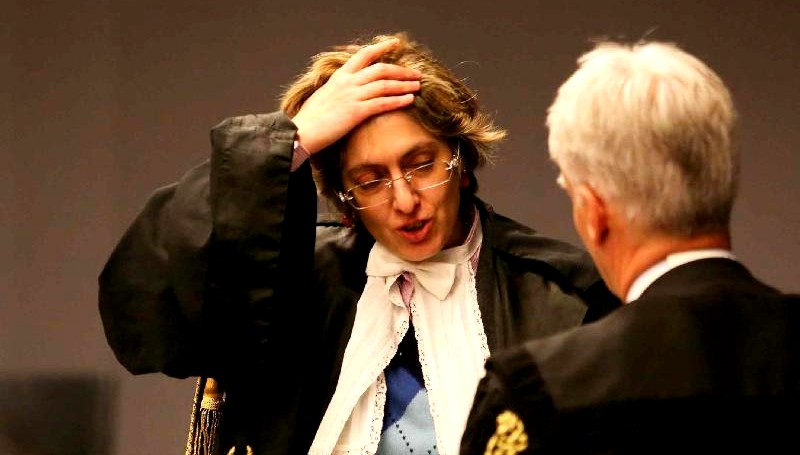
Only half pieces of evidence, almost a half admission, or the clear suggestion that there is maybe one “other half” of something (of culprits?) somewhere else, something not to be said, something that is not here.
The concept of “half” recurs and somehow pervades her defence, we should say something more about later on because she picked it up also in the subsequent hours of speech.
Some videos from the Florence trial available may still be available at the Sky site.
Primordial Fossils
Only after recollecting all these things in the “˜aggressive digressions’ over the introductive part, she goes on with a ponderous section which is the main part of her argumentation.
It’s a topic directly stemming from the introductive themes and premises, in the sense that this main part focuses on and blows up events of the first four days of investigation. It zeroes on few small details of the investigation history, the previous introductive part functionally working to justify the choice and to limit the argumentation to these topics.
Something the listener would notice from this first and main part of the arguments, as everyone well understands, is that these arguments are arranged in a peculiar type of architecture. A choice that makes crystal clear the actual state of the defence’s options.
The defence strategy is to focus attention on the supposed flaws in evidence collection at the beginning of the investigation, and not on the evidence set itself.
Bongiorno’s arguments do not map out the evidence set array. They do not devolve an effort of analysis in proportion to the actual weight of the of pieces of evidence.
The bulk of her speech in fact can be summarized as a criticism of some historical happenings ““ what she sees as such ““ which allegedly occurred within a very small time frame. She devoted hours to attacking the beginning of the investigation, early errors such as that the shoe print that had been wrongly attributed to Sollecito on a first assessment.
It appears this attack against the early procedures of the investigation was really considered to be the most effective weapon the defence had left.
The “˜topics’ Bongiorno addressed in this attack as “˜main points’ of evidence against Sollecito, are only three: the wrongly attribute shoeprint, Sollecito’s side-tracking the investigation, and “˜the knife’ (a topic which gets picked up again later, with a long discussion focused on the blade length).
In the same “˜knife’ topic she included DNA discussion, in a connected digression she dealt with the bra claps, called all the scientific evidence collection “˜the mother of mistakes’ and offered again the known criticism of Stefanoni’s alleged “suspect-centred”.
Later in her speech, she dealt with the other evidence topics, parroted the “˜principles’ expressed in the Conti & Vecchiotti report, offered the known arguments about the bathmat print, etc.
But the bulk of her defence hinged around those “˜mistakes’ in the early investigation phase, this was the actual core of her argumentation, while the other pieces of evidence were dealt with summarily, I had the impression they were almost treated as accessories.
It was clear above all that the defence was not battling the structure of the evidence actually existing today, they were battling a minuscule part of it, or better they were battling something else, something which is not directly the evidence, but rather some historical foundations of the accusation building.
Basically what Bongiorno conveyed is, the fighting terrain was the “˜investigators’ errors’, their “˜excesses’. That is, they were not actively contending Raffaele’s innocence any more.
The implicit content was rather obvious to the listener: a direct claim of Sollecito’s innocence had been already abandoned, that territory was left beyond the lines and the defensive front had been drawn back.
The topic now was not innocence, but rather how the accusation had been unfair and excessive.
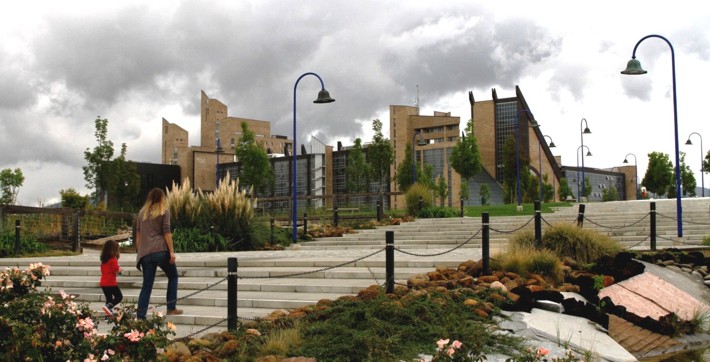
At her opening, the quote of Satta was a device to draw attention to the events at the “origin”, so as to prepare listeners for the fact that defence arguments will be focused on what happened during the moments before the “black curtain” came down.
Hence the a long introduction starting from an image of the fury of a mob of sanculots, a narrative on this theme: people were willing to convict the defendants immediately and judges were legitimizing people’s violence.
She oriented the discussion towards the topic of early prejudice and excesses, so to justify the fact that she will talk about the early phases rather than the evidence set, and then she introduced the leit-motiv of the “half”.
This means, rather than disputing the pieces of evidence, Bongiorno wanted to set a “trial of the investigation”, she zeroed on just a few details actually not having much relevance in the actual evidence set.
She talked at length about elements that are kind of fossils ““ like when she went on discussing about the number of circles in the sole of Guede’s shoeprint ““ putting the alleged “errors” in the course of the investigation on trial, and her speech at times sounded as if it was a lecture about dinosaurs, recalling curious things now extinct.
The explicit function of her introduction was to justify her setting aside the evidence set, downplaying it by framing it into a historical moment, maintaining that it was collected and interpreted when investigators were already beyond the “black curtain” of bias, therefore tainted by prejudice, while judges were like sycophants before an angry mob.
The purpose behind the Black Curtain
The implicit, most important function of the introduction was accomplished via the concept of “half” and all the subliminal suggestions attached.
We should ask ourselves: is it reasonable to believe Bongiorno was so naïve to expect that the court may accept a theory about a dismissal of evidence in limine?
The answer is no. Bongiorno knew perfectly well that her preliminary criticism of the investigation would not lead to a dismissal of the evidence.
Bongiorno also knew that the series of preliminary arguments she would offer would be considered ineffective by judges. Such as that the knife DNA should be seen as unreliable preliminarily, that Stefanoni’s work lacked “transparency”, that Vecchiotti and Conti’s “method” should be taken at face value (Bongiorno knows C&V’s intellectual honesty was called manifestly questionable by the Supreme Court ), that this and that allele in the bra clasp DNA should not be considered because, etc.
She also knows that this court will not allow pieces of evidence to be considered separately from each other in a parcelled out way, and that imperfection of single pieces themselves do not work as a logical argument. Even less could she dismiss the evidence based on political and anthropological theories.
From the fact that she was setting afoot on a trial of the investigation instead of battling the evidence, the rational listener infers that she is well aware of the weakness of her position, since it implies that the evidence set as the battleground would be indefensible. She needs to search for another terrain of attack, a different structure, as the only possible move.
But there is also another implication. She does need to engage and draw attention to areas where she could “win” something, but this also means that her intent was to “soften” the accusation, to work it out at the flanks rather than face it frontally; to reduce the size of some fundamentals, the “excess” of the accusation.
In other words, to shorten the sentence. And if possible, to separate Sollecito’s position from that of Amanda Knox, albeit within the boundaries of her client’s plea.
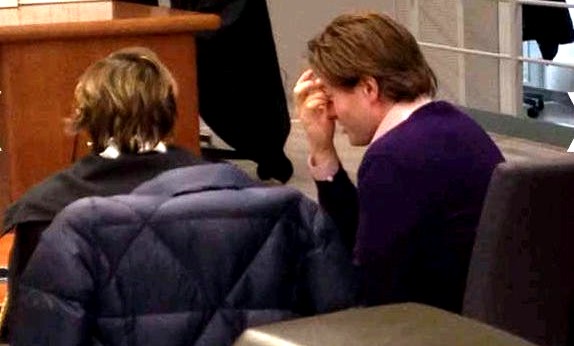
Her strategy of attack had a reason, that was to try to soften the accusatory attitude against Sollecito. Besides being risky (may sound extremely unconvincing) the strategy was also loaded with implicit meanings.
What was most stunning to me ““ as it was a recurrent topic through her whole speech ““ was the concept of “half”. She picked up this introductive theme several times, such as while speaking about the medical findings explaining that only “half” the length of the blade would be used, if a knife so large as Sollecito’s kitchen knife was used, saying that, in this event, this would mean the perpetrator did not intend to kill and killing was the effect of “mistake”, an involuntary movement.
The importance of the length of the big blade and its “half” was emphasized by a waving of knifes, in a quite impressive theatrical performance: “Either the big wound was made by a smaller knife” that was held by “someone else” or the knife was “plunged only by half” showing there was no intent to kill.
All this is to be coupled with the fact that, as said above, she devoted a main portion of her 6-hour speech to discussing things that are fossils, elements not existing any more.
She dealt later with other pieces of evidence too, though in a way that seemed somehow marginal, and she did not deal with some of them at all - the inconsistencies in Knox’s account, for example, were left completely out.
She was not that kind with Knox’s written memorials either, calling them “farneticanti” (waffling, raving).
I noted her complaining about Raffaele being “halved”, as his character is portrayed as depending on Amanda’s and thus seen as equally guilty insofar he was Amanda’s half ““ and this effect is somehow transferred to pieces of evidence.
Bongiorno’s rhetoric emphasizes that Sollecito was accused on “half” pieces of evidence (you perceive that the metaphorical repeating of “half” implies that evidence actually exists, “by half”, and at the same time this complaint about being seen as “half” of something is a subliminal suggestion that the defendants should be considered separately, and their charges as well, thus maybe their responsibilities if considered separately may be different; and when it comes to discussing how the murderer used only half of the blade, the subliminal suggestion is bring down the charge by half, involuntary event/manslaughter versus voluntary murder).
The Mark of Infamy
Giulia Bongiorno picked on the investigators and acted as if she was putting the investigation on trial not because she thought that this would lkead to the defendants being found innocent, but exactly for the opposite reason, because she expected them to be found guilty.
Insults against Prosecutor General Crini, against witnesses and and gratuitous accusations are a risky path but they are also an overt attempt to “soften” the investigation scenario, rather than fight it frontally.
She had no hope to make her client look innocent, her only hope was to soften the strength of the accusation, to make him look less guilty, not so bad as the investigators saw him.
She pursued this in two ways, by suggesting that he should not be seen as the “half” of another perp but rather his responsibility should be considered separately, only that evidence which proves directly against him (Bongiorno repeatedly pointed out that Knox did not utter his name in her interrogation and statement), his actual responsibility might be much lesser than the charge for which he is accused.
The other arm of the defence’s pincer move, the second way to try diminish the accusation, was to portray the investigators in bad light. The “˜excess’ of accusation was to lay blame on investigators for their bias and errors.
Bongiorno’s attack against the investigation might be intended to achieve a psychological effect due to comparative process.
If you consider how the police are responsible for “˜excesses’ and disputable behaviours, you may think the investigators have been prone to gross mistakes that lead to exaggerating Sollecito’s implication, thus the accusation should be not be taken at face value and should be corrected. Maybe the correct assessment of evidence proves he not as much implicated as they had thought.
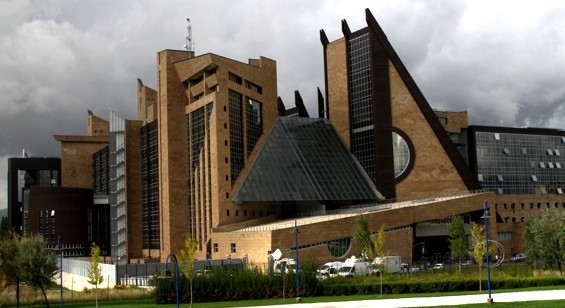
This seemed to be Sollecito’s own defence strategy, albeit implicit, since Bongiorno must restrain her action within the boundaries of her client’s plea.
In order to follow her strategy, however, Giulia Bongiorno decided to take a few steps which must be pointed out as particularly reprehensible and infamous.
I was surprised and stunned by those action because they qualify the character of Giulia Bongiorno as far worse than I thought, I really did not expect her to stoop so low.
The infamous part of Bongiorno’s speech is her gratuitous name calling and defamatory attack against Anna Donnino, her attempt to smear her professional reputation and the rude insult in calling her a “˜psychic’.
In real life Anna Donnino is a very respected professional, she has been working for the Questura on tasks of interpreter and language mediator (not as a “˜translator’).
She is also an intelligent person, she is precise and expresses herself with the utmost clarity as her lucid testimony shows.
She is known not only for having unquestionable professional ethics, but also she has an excellent reputation as a person; she is honest and humane and known by everybody for her extremely reassuring, protective temperament, and for her expertise and excellent performance of working with people.
She would help immigrants in difficulty to express themselves and understand their rights and was priceless helping the police to obtain precise information in their investigations.
As an expert in chuchotage and linguistic mediation from two foreign languages, the professional quality of her work is excellent. Her training and work is of interpreter and language mediator although sometimes shee is given translating tasks such as the translation of recordings and wiretappings.
The Questura of Perugia used to hire “˜language mediators’ at the time. You don’t know what a language mediator is? See a university course for a degree in Language Mediation.
The Questuras of some bigger cities also have “˜cultural mediators’ in addition. They are mother-tongue trained to deal with African or Chinese immigrants (one of the many young people having their internship as cultural mediator in a Questura is shown here.)
To me, this defamatory attack against Donnino was most disturbing. By doing this Bongiorno came across as surprisingly mean, I’d say what she did was really infamous.
Indeed this was not the only virulent attack, it came after insults to the city of Perugia as she was comparing its citizens to a mob of blood-thirsty fanatics.
This attack too is also particularly vicious, since it exploits, inflames and is subtly synergic with the tones of lies and prejudices disseminated by a perfidious propaganda strategy.
But at a certain point, Bongiorno focused the defamation against one person. As she unfolded a narrative about Anna Donnino acting as a “˜psychic’ who managed to hypnotize, to gaslight Knox to the point of inducing a state of trance in which she mistook a dream for reality, some people couldn’t help laughing in the courtroom.
But even if we consider the surreal and comical rather than the convincing effect, the defamatory intent stands out as reprehensible and humanly vicious.
This is because, as I said above, these particular insults were directed against a person distinguishable for her being a most decent, honest and trustworthy character, and also ““ a further reason ““ because of the recent events for which this person experienced personal suffering: Anna Donnino, a mother of teenagers, has been struck with cancer, and has undergone surgery.
She is under treatment but still currently remains in very bad health.
The attack against Anna Donnino is an action that rebounds as an ugly stain on the reputation of those who launched it. A young man from Perugia created a Facebook group to express a the citizens’ “hate” for those who lead a defamatory campaign of lies against the city. He collected over two thousand likes within three days.
Some of the comments were about Bongiorno’s insults against the city and against respected citizens, pointing out her outrageous hypocrisy since Giulia Bongiorno poses as a campaigner for the respect and dignity of women.
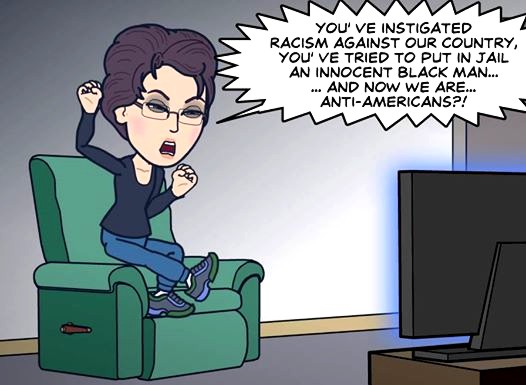
(a StripBit comment by a poster on a Facebook group)
Criticism of Giulia Bongriorno pointing out her hypocrisy is actually not a novelty, it has appeared long since in the press and on the internet.
But it’s hard to understand how someone like her, promoting an image of herself as an advocate for women and for correctness and respect in language and culture, could take such a an egregiously visible false step, come out with such stupid stereotypical rants, only for what looks like an awkward and useless cause.
Conclusion
A note for the record: we may recall Bongiorno has also attacked the Perugian police officers, citing the recording of some of their phone conversations in which they say bad words about the Sollecito family.
We can understand her outrage (at least we could, if only she were not the hypocrite she is) but at the same time we can’t fail to notice that she “forgot” to mention another half of the phone call recordings.
Specifically those where the members of the Sollecito family were speaking about the police officers; and the kind of language they were using, while attempting to plot “˜under the table’ help from some politician.
Expressing their intent to “˜scorch’ officers and “˜destroy’ magistrates, and one person even suggested that if he met Monica Napoleoni on the road, he would kill her by “˜running over her with the car’ then flee without telling anything, pretending that nothing happened.
Never mind.
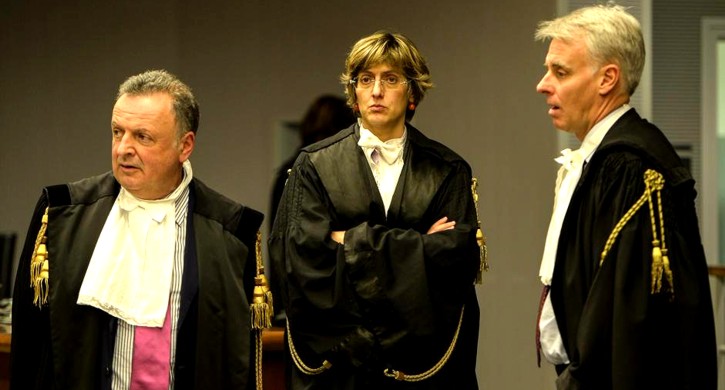
After these last sparkles and the knife waving Bongiorno’s performance was over. In the following day’s hearing it was Maori’s turn. As a really last resort, he was taking on the task of disputing evidence in a more “traditional” way, objecting to points of evidence.
Possibly this revealed even more the extreme weakness of the defensive argument (a commenter called it “˜pathetic’). I did not listen to his argument myself, I only notice that he did not get much space neither in the press nor in the pro-Knox commenting sites; this might be a clue of how unconvincing he might have been.
One thing that however I could learn about it, is about the feeling, the perception that Maori pointed out even more the separation between the two positions of Amanda Knox and Raffaele Sollecito.
A hint about this comes in the words of a journalist who was questioning Alessandro Nencini in the lounge immediately after the verdict: the journalist pointed out how Sollecito defence “tried to split the positions of the two accused”.
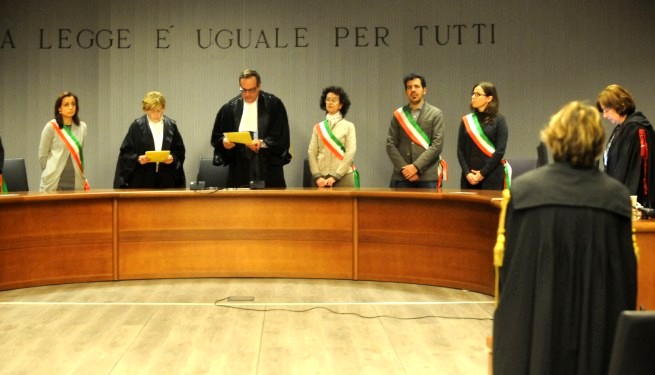
This mild attempt of a separation was the last act by the defence. As for Raffaele Sollecito himself, we were left with his rather different claim, his book where he described himself as sticking to a “˜honour bound’.
He reportedly bragged about this also with his ex-girlfriend Kelsey Kay, who described him as feeling very entitled because of his loyalty to Amanda Knox and believing she owes him a vital a favour; but Knox won’t even respond to his messages.
Then, we had his final admission in an interview that his friendship with Amanda Knox has “˜deteriorated’, because apparently Knox in practice no longer supports him as before.
If his defence advisors understood that they needed to somehow “˜separate’ his position from Knox’s at any cost, despite his plea, to suggest he may be implicated but just “˜less’ guilty, we may only agree with them on this. It would also be convenient for him to confess even if he shared the same degree of guilt of Knox.
Sadly, instead he still felt compelled to offer further lies and changing stories such as”˜I noticed no blood on the bathmat’ when questioned by Kate Couric; he offered again a story of pricking Meredith’s hand while cooking together at the cottage.
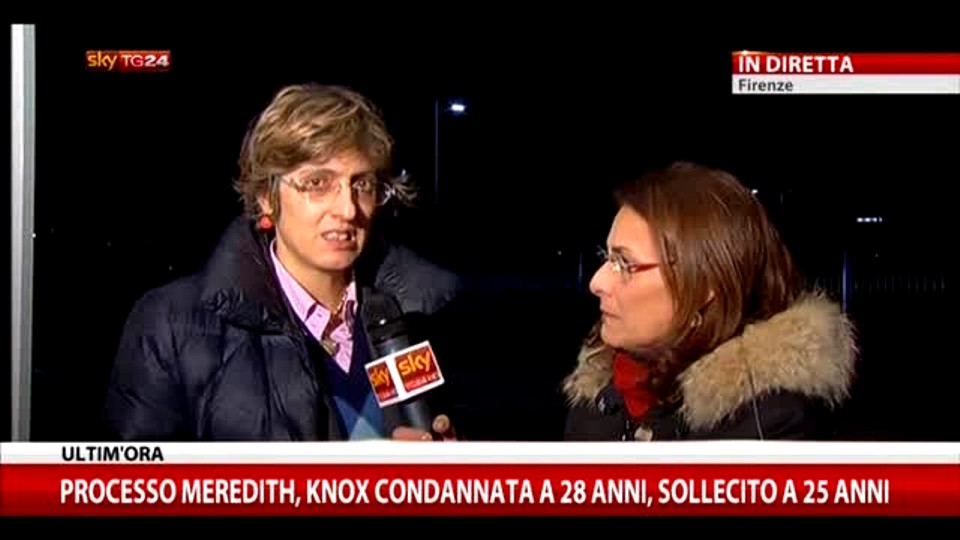
Other murderers, who committed even more heinous crimes, have recovered and rehabilitated themselves after time spent in prison; even some of those deemed among the worst serial killers managed to do this by expressing remorse ““ for example the rather psychopathic “˜Ludwig’ (Furlan & Abel) killers.
Sure after the years he will spend in jail for the gang-like crime he is found guilty of, there would be a possibility for a “˜casual murderer’ such as he is to be perceived as rehabilitated. But to see him as “˜less guilty’ or as “˜rehabilitated’ would be impossible as long as he remains silent or denies.
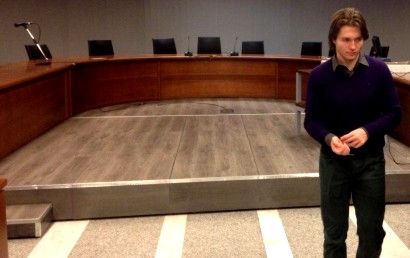
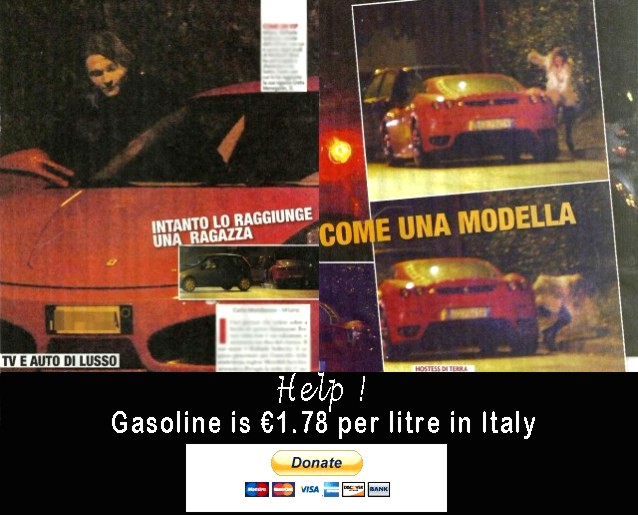
Wednesday, February 26, 2014
How Claims By Perpetrators & Their PR That THEY Are Victims Get Equal Pushback
Posted by Peter Quennell

[Florence prosecutor Giambartolomei will soon confront many false claims ]
To the considerable pain of victims and their loved ones, Italy’s has become one of the most pro-defendant justice and penal systems in the world.
That doesn’t mean that it has become a complete pussycat. Push it, and it usually pushes back harder in its search for the truth. And the quality Italian media goes along.
Time and again the ill-conceived short-term PR and legal tactics for Knox and Sollecito based on a hurricane of lies have left them in terms of the ultimate end-game worse off than they were before.
Judge Matteini and Judge Micheli (the judges in 2008) both took firm lines with the copious evidence and the psychological tests of AK and RS in front of them.
Both judges took a line as firm as the prosecution (as firm as the “evil Mignini”) in concluding that there was a drug-fueled hazing escalating to murder with sexual aspects (however short the timescale of the intent).
[Ed note: See comment by Yummi below which explains the above a little differently. PQ.]
Though his panel of judges voted unanimously for guilt, Judge Massei in 2009 did take a somewhat less firm line in the sentences, after observing one daffy defendant and one very nervous defendant sitting in front of him for nearly a year. Judge Massei for no especially convincing reason
(1) pinned the initiating of the attack on Rudy Guede (really?!) and
(2) handed Knox and Sollecito (and thus Guede) quite a break with his supposed “mitigating circumstances” (the duvet over Meredith’s body) resulting in 20 years lopped off their combined sentences.
Both the defenses and the PR were weak and largely futile in that year. But come 2010 the dirty tricks moved into overdrive.
Cassation reverted to the firmer line in January 2011 when it ruled on Guede’s final appeal: Guede was a party to the murder, but copious evidence proved he did not act alone.
The Hellmann appeal court and DNA consultancy and verdict of 2011 were corrupted (counter-measures are still quietly playing out) which fully explains its startling soft line.
Thereafter the Italian courts observed the illegal blood-money binge with the essentially fictional books of Sollecito and Knox, and two years of them each claiming to ill-prepared interviewers “we’re the real victims” on TV.
Cassation observed all of this, annulled the corrupted Hellmann court verdict, and issued instructions in June 2013 to the Florence appeal court to ensure that the firm line should be maintained. Unsurprisingly, we have seen a firm line from the chief prosecutor (Crini) and a seeming firm line from the lead judge (Nencini) in recent weeks.
In the rest of this year Italy will see at minimum these events where the court’s firm line will go on and the babbling and unhelpful legal and PR tactics may finally dry up.
- 1) RS and AK continuing to babble for a while on TV as they each dig the other one deeper. Sollecito has just said that his saliva or sneezing may explain why his DNA was on the clasp of the bra.
2) The sentencing report of Judge Nencini is due at the latest on 30 April and he seems likely to give space to rebuttals of any bizarre new claims made by Knox and Sollecito before 30 April like the one just above.
3) The obstruction of justice trials of witness Luciano Aviello and incessant meddlers Mario Spezi and Frank Sforza will continue, probably though into 2015. Each of those trials could result in others (like Spezi ally Doug Preston and Sforza allies Bruce Fischer and Steve Moore) being declared at minimum persons of interest if not actually charged.
4) Florence prosecutor Giambartolomei Firenze (image above) may soon be announcing which passages in Sollecito’s book Honor Bound criminally defame Italian officials or deliberately miscontrue hard facts in evidence in an illegal attempt to to poison public opinion against the court.
5) Similarly soon after on Amanda Knox’s book with the surreal title Waiting To Be Heard (and on Knox articles and interviews in Oggi) by the chief prosecutor in Bergamo.
6) Cassation’s First Chambers should be the one to handle Knox’s and Sollecito’s final appeal. They handle murder cases and they issued the guidance to Florence in 2010.
7) If so, they should take note of such revelations by way of Judge Nencini’s and Prosecutor Crini’s reports; and this next autumn or winter may finally declare a firm “confirmed guilty” final-appeal outcome and invite Knox to come back.
And when prosecutor Giambartolomei Firenze announces which claims are radiocative, hopefully a major hush will come over Heavey, Fischer, Bremner and Moore.
Friday, February 14, 2014
Hard Questions By Italian Journalist Giuseppe Castellini For Sollecito
Posted by Peter Quennell
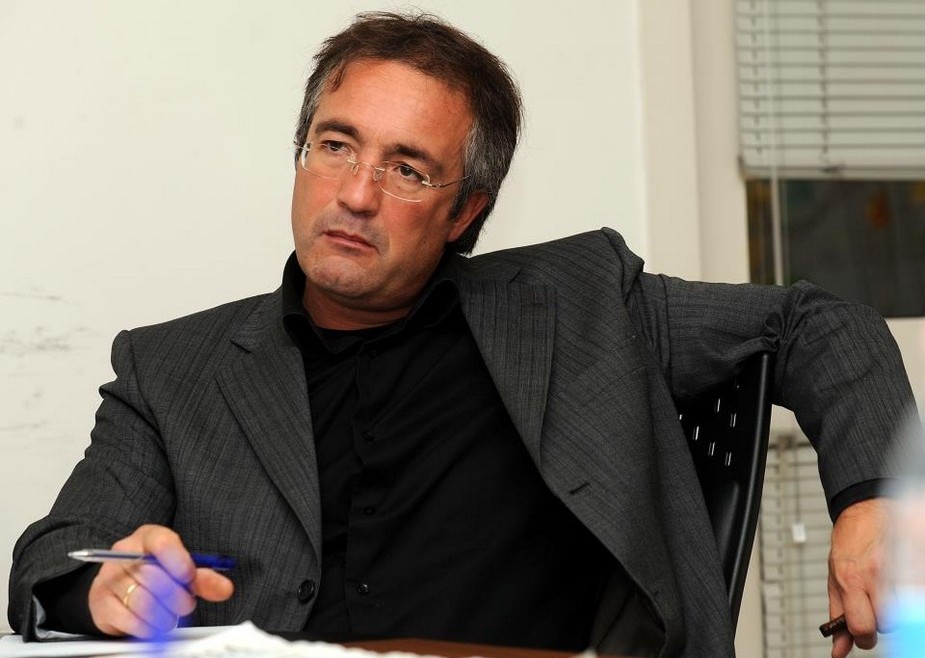
[Above: Giuseppe Castellini of Giornale dell Umbria has long exposed the Knox/Sollecito lies]
1. Overview Of Italian Media Takes
The fast-growing satires of Knox and Sollecito in Italy described in our previous post are not just emerging in a vacuum.
The many tough crime-show comperes and crime reporters in Italy have rarely let Knox or Sollecito get away with any of their lies. One example was when Bruno Vespa, the host of Porta a Porta, Italy’s most popular crime show, forced Francesco Sollecito to admit to Italy that his son lied extensively in Honor Bound. Another example is when Oggi published some of Knox’s lies and they were rapidly exposed. For seemingly endorsing Knox’s lies Oggi will face trial for obstruction of justice.
There are countless other examples where Sollecito and Knox have been exposed as liars. The super-sharp editor of the Giornale dell Umbria, Giuseppe Castellini, has just published this challenge to Sollecito who had absurdly had claimed that nobody ever wanted to ask him any questions in court.
2. Giuseppe Castellini Questions RS
The translation is by Miriam.
Murder of Meredith: a few questions for Raffaele Sollecito
Raffaele Sollecito, found guilty and condemned to 25 years by the Appeals Court of Florence, for the murder of the English student Meredith Kercher (for the same crime Amanda Knox was also found guilty and Rudy Guede is already serving a definite sentence of 16 years) has stated that he was never questioned in court, because no one ever asked him.
For the record and in order to have a complete picture at, it should be remembered that during the investigation, Sollecito twice took advantage of his right to not respond to the questions of the PM Mignini.
So if it’s true that the prosecutors, in all the trials never asked to question him in court, neither did he ask to be, limiting himself to giving several times making spontaneous statements, without being cross examined.
However, this is not the real point. The fact is that Raffaele could not or did not want to respond to the questions of the investigators.
His version was always brought forth in detail by his lawyers, obviously, but that is not the same thing.
Important questions remain to which Raffaele did not answer directly during cross examination by the Prosecutors. Let’s try to summarize some crucial unanswered ones. Who knows if Raffaele will ever decide to respond in detail right here on these pages even though ““ at the moment ““ it seems improbable. We address him directly, sure that he reads these pages.
1. The first time that you were questioned in Questura you said that the first of November 2007 (Meredith was murdered the night between the first and the second of November) after a walk through downtown Perugia (before that you and Amanda have been in the house in via della Pergola). You came home around 08.00pm while Amanda come back much later around 01.00am, you then changed your version saying that you had always been together. Your first statement seem like a distancing from Amanda, in those hours nobody knows what she did, while the second one has a complete different flavor. Why did you radically changed your version?
2. It’s proved by the findings (even if your lawyers contested it) that the computer in your house was activated for about half an hour from 05.32am till little after 06.00am of the second of November. For the experts of the Police it was certainly a human interaction. You, instead declare that you and Amanda were sleeping. So who was it then that was using your PC at that hour?
3. Your and Amanda’s cell phones were turned off at the same time around 08.40pm of the first of November and they were turned on, practically at the same time, a little after 06.00am of the second of November (at that time you received the “good night” sms sent from your father the night before). How do you explain all this?
4. You stated that you were not in the house in via della Pergola. How it is possible that your DNA is on the bra clasp (17 loci that shows your genetic profile, and for the father of Italian genetics, Prof. Vescovi, that with the current processes are not only enough, but more than enough to match your DNA). And why did luminol revealed a bare right foot print compatible with yours, in addition to the one on the bathmat in the small bathroom? (the size of the big toe, just to point out one thing, is just like yours, while Rudy’s is a lot smaller).
5. Why, if Rudy was the only assassin, in the corridor would he cancel only the bare foot prints, leaving in plain sight always his, but left with the shoe print of his left foot? Doesn’t it come to mind that whoever cleaned up the prints thought to cancel theirs (specifically the ones ascribed to you and Amanda) leaving behind those recognizable as Rudy’s?
6. You and Amanda were seen by the homeless Antonio Curatolo late the night of the murder and Amanda was seen by the shopkeeper ““ that knew you well and already saw you with Amanda ““ enter in the shop at about 07.45am to buy something and go back toward piazza Grimana. You and Amanda say that at that hour you were sleeping in your house. Is there something that can demonstrate this, that up to now has slipped away and that would give you the missing alibi?
3. Questions For RS Of Our Own
We have advanced plenty of questions for the evasive Sollecito of our own. Here are seven examples.
- Questions For Sollecito Do You Stand By Your Smear Of Reasonable Doubt In Italian Law?
- Questions For Sollecito Why Claim Guede Did It Alone When Vast Evidence Contradicts That?
- Questions For Sollecito Why So Many Contradictory Explanations Of How DNA Got On The Knife?
- Questions For Sollecito Did Your Father & Lawyers Pre-Approve This Crazed Rant?
- Questions For Sollecito Can You Realistically Account For The Hard Evidence On The Bathroom Mat?
- Questions For Sollecito Katie Couric, Push Back Against Sollecito’s Bluster And False Facts #2
- Questions For Sollecito Katie Couric, Push Back Against Sollecito’s Bluster And False Facts #1
Tuesday, February 11, 2014
The Much-Demonized Rudy Guede Is Back In The News And Increasingly Threatening
Posted by Peter Quennell
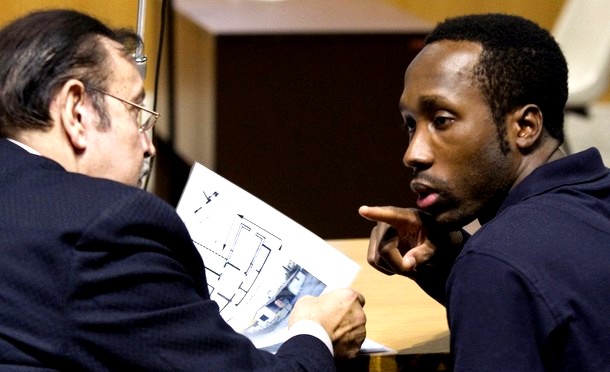
Rudy Guede has long DELIBERATELY been demonized so that the attack on Meredith can be assigned to him alone.
This description of Guede’s early days in the Ivory Coast and Perugia in the excellent Darkness Descending by Paul Russell and Graham Johnson remains the ONLY one that fully checks out. Certainly not that by the dishonest PR shill Nina Burleigh.
Guede wasn’t especially an angel, and some in Perugia were iffy about him. But he had real friends, and up north he held a real job with a real career future, until that prospect imploded and sent him haplessly back to Perugia.
Late in October 2008 Judge Micheli discounted all that Guede ever said about his role in the attack on Meredith in various conversations and statements, and sentenced Guede to 30 years.
But Judge Micheli also concluded that there was no firm evidence either that Guede acted alone or that Guede was a drifter, drug dealer, knife wielder or burglar (Micheli was very sharp with one witness who claimed Guede may - may - have broken into his house).
In 2009 through his lawyers Guede enquired of the prosecution whether he might testify at the Knox-Sollecito trial.
But the prosecutions’ hands were already tied by the indictments and they (rightly) believed they had a really strong case regardless of anything Guede could add.
At the 2009 trial the defenses pussyfooted around and never settled for a firm position on Guede. They floundered in their subdued attempts to prove that Guede or somebody else unknown was the so-called Lone Wolf.
The Lone Wolf theory is really a zombie theory with so many stakes through its heart that no court will ever take it seriously.
Guede’s steadfast fallback position before and since was that he was only in the house on the night of the attack because Meredith invited him to come in and they began love-making.
At his late-2009 first appeal and also at Sollecito’s and Knox’s 2011 appeal before Judge Hellmann, he increasingly firmly pointed the finger at Knox and Sollecito as the murderers.
Guede had been initially inclined to let sleeping dogs lie after he was mysteriously beaten up in the sex offenders wing of Viterbo prison, where prisoners are meant to be kept very safe.
But Judge Massei’s scenario of the attack on Meredith in his March 2010 Sentencing Report, with Rudy Guede as the lead instigator, really bothered him.
And in mid 2010 he became even more bothered when claims were made by a fellow prisoner the baby killer Mario Alessi that Guede confided that he really had committed the murder, along with two others. Not with Knox and Sollecito.
A very angry Rudy Guede in turn wrote a letter denying this which very rapidly went public.
In 2011 there was a tense confrontation in the Hellmann court (which several times descended into chaos) when this letter, in which by now Guede firmly accuses Knox and Sollecito, was read out for him.
Guede stuck to this position on the stand, and he was not required to face full cross-examination by the shrill, frustrated defenses because he was already convicted and no longer the one on trial.
Seemingly fed up with all the dirty tricks against him and the now-incessant Knox and Sollecito mantras in the media that Guede had acted alone, he has come out with another letter.
Italy’s AGI News Service has posted this letter to an unidentified recipient, along with this report.
(AGI) Perugia, February 11 “Against me are being repeated false imaginated reconstructions of the crime for the sole purpose of wanting to denigrate my figure and person, systematically and in a negative way, in the public eye and not just in Italy.”
He apparently also posted what he wrote in his own hand on the Facebook page “Legal processes and their surroundings”...
The letter is on a sheet of notebook paper handwritten and signed by Guede.
“To my regret I am again forced to take a pen and paper and write for the sake of the truth.. to all those thousands of people who still believe in justice.”
“They can not access all the pleadings and components of this sad and extremely complex legal case which was dramatically painful for those who lived it . My sentence and judicial reasoning have been for too long subject to a continuous and willful manipulation and alteration of the data of the proceedings.”
“Against me are made continuous false and imaginary reconstructions for the sole purpose of wanting to denigrate my figure and person, systematically and in a negative way in the public eye and not just the Italian.”
“In the final judgment, as far as I’m concerned about these false and imaginative reconstructions, is that I was acquitted of theft and simulation of crime, a fact that I never hear mentioned in the various journalistic reconstructions.”
“I also want to point out I do not accept in any way to be passed off and continually held up as a drifter, a thief, a homeless man, seeing my person and my dignity offended continually, denigrated and stereotyped by facts and things that do not realte to me… when I had a beautiful family and precious squeaky clean and friendly relations in Perugia.”
Fast-forward to today, where reports say that Guede is getting close to day-release for study purposes and may only be months away from making more evidence against Sollecito and Knox public.
Our posting lawyer TomM has looked at the issue of Guede being allowed out to study, and finds it regular and humane in this assessment.
I respect the Italian system of criminal justice. Just as I recognize that the Italian courts have much better information than anyone posting on the internet relating to the culpability of the defendants in this case, I also think that the people who oversee Guede’s stay in prison are better informed as to his fitness to be reintegrated into society. That he would be allowed out during work days to become better educated, returning to his prison cell at the end of the day seems to me a more enlightened approach than what we do here.
We used to have training programs in prisons. I don’t know that they were “cushy”, but they did work, so that when these convicts were released they were equipped with a marketable skill and rarely re-offended. But, the public thinks these were too cushy, so more Draconian circumstances and longer sentences are now the norm. It used to be people were sent to prison as punishment, now they are sent for punishment.
Sometimes when a prisoner who has spent his or her entire adult life in prison completes the sentence imposed, they have to be physically dragged from their cells, so ill-prepared are they for anything other than doing time. With no skills, social or job-related, they re-offend—surprise, surprise. Sometimes re-offense is for the purpose of being returned a world that, for all its dangers is, to them, relative safety.
While it is certainly true that prison doesn’t have much impact on sociopaths, the one thing they are attached to is money. Taking away their money does impact their behavior, so there is an alternative to killing them.
Friday, February 07, 2014
The Hubristic, Meanspirited PR Campaign: What Sort Of Life Has It Left Knox And Sollecito Now?
Posted by lauowolf
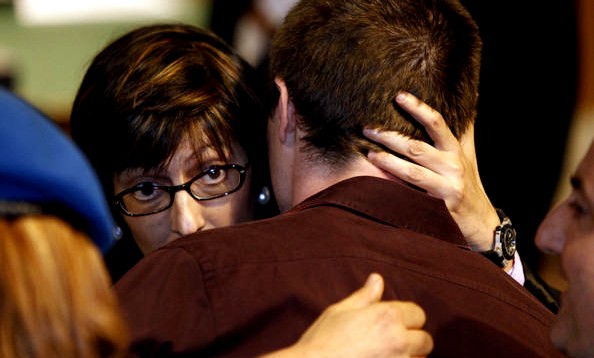
Sometimes it can be frightening to see how people’s self-interested choices turn around to bite them instead.
Had Knox and Sollecito simply told the truth to begin with, this case would have been only a nasty local story in Italy, with a bit of light coverage in Seattle and London. They would have had to accept some narrative that explained their involvement and their guilt, and they would have been sentenced accordingly.
They would then have served their time and gotten out. Eventually they would have gone on, perhaps, to live relatively normal lives.
After all, by the time they left prison virtually no one outside the families involved would remember, or much care, what they had done. Their criminal records would follow them forever, of course, but certainly there would have been no public repercussions for an obscure murder in Italy, years in the past.
People live with such pasts: they live their lives and create a future despite their pasts.
Instead, Knox and Sollecito have rendered themselves toxic for the rest of their lives. Everywhere they go, as long as they live, they will be recognized, whispered about, and pointed out by supporters, opponents, and even the relatively uniformed public.
Always.
Already, Sollecito’s Austrian side-trip was busted by someone who, predictably, recognized him. The intense paparazzi effect will eventually wear off, but years from now, whenever either of them does something simple, its effects will live on.
Apply for a library card ““ instant name recognition, walk through the airport - and someone will realize why that face is familiar. They’d better get used to it because some stranger will always recognize them. At their every life event, there will be a news alert, and someone potentially selling the story or a photo.
They and their families deliberately established an intensive PR effort for selfish reasons: in order to avoid the repercussions of a terrible act.
But this press creation is a terrible beast. Now that it is here it will need to be fed. Always. Get drunk in public - someone will have a cell phone handy; a marriage breaks up - the ex-spouse will tell all. (And, really, neither of them has the kind of money needed to live forever insulated from the vulgar public.)
For the rest of their lives, in everything they want to do, the whole did-they-or-didn’t-they narrative will be weighed in other people’s reaction: Would you hire either of them for anything? Would you rent them an apartment? Elect them to the school board?
All other things being equal, there will always be someone else available, someone equally good who has no awkward history. And everyone will know about that history; they worked hard to make it so.
And I’m not talking about the prejudice against ex-cons. That’s a real thing, and it will have its impact too. All convicted felons have real problems, after all, but few of them have achieved such notoriety, let alone embraced it. What I’m talking about is the impact of even old-news celebrity, of always now, and for the rest of their lives, being tabloid fodder.
Sure, there will always be people (Mad Pax?) drawn to the faux glitter of it all, but a life accompanied only by those wanting to share in your “fame” seems pretty ugly to me. What normal person wants the hassle of becoming involved with something like this?
Furthermore, they will never know when someone they think of as a friend might suddenly start thinking of a way to cash in. There might be a book in it, or at least a juicy article for a tabloid.
This isn’t meant as expressing any kind of sympathy for them at all, by the way. They have blood on their hands and horrors in their heads.
Eventually they may come to some kind of terms with their actions. Frankly, though, I hardly care, for it is not merely their crime that requires expiation. I have been sickened to see the unfolding ruthlessness and the sheer ugliness of their publicity campaign.
At its center their PR beast reveals an utter selfishness that is willing to appeal to the worst in their supporter through appeals to American xenophobia, to racism, and in smears against Meredith, Rudy, and Patrick, as well as the entire system of Italian justice.
The PR beast they created denigrates every other element in the case, while portraying the pair of them as young, innocent, and only guilty of a visible passion for each other and a naïve belief in the police.
This tactic required a media product for sale: the attractive young lovers. Their campaign has forced their names, and images and story in all our faces for years now. They and their families did this entirely voluntarily, and they have seemed to relish the attention it brought them.
They’ve been interviewed extensively, treated sympathetically by those who should know better, and altogether have had much more than their fifteen minutes of fame. But celebrity is a beast that turns on its own.
And, importantly, unlike other famous people ““ actors, politicians, authors and the like - there is no proper use for their fame. They have nothing real to share with us, only their story. It is, literally, all about them. And that is how it will remain.
They have become a narrative whose next chapter will always be told. The PR beast, for all its reach, will not be enough to keep them out of prison. But the cameras will be there the day they finally leave prison, in case we have forgotten their faces.
And there will be photos when they drive drunk. Or marry. Or divorce.
Their names are out there, waiting for the tagline, waiting for the joke. (“How bad is your new roommate? Well, at least she’s no Amanda Knox.”) There will be no end to it, ever. They will have no privacy, ever. Karma at work is a scary thing. They invited the beast into their lives, and now it will never leave them alone.
[Below: Said to be Amanda Knox leaving home hiding under a windcheater]
